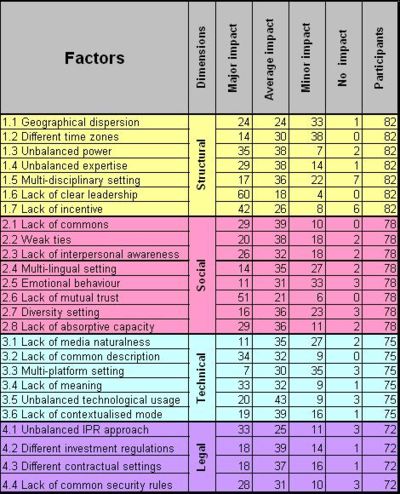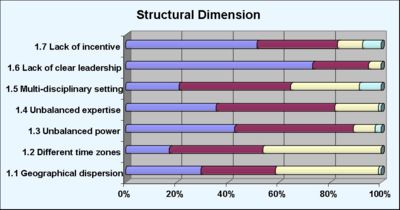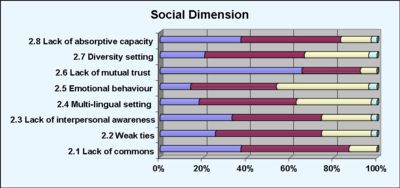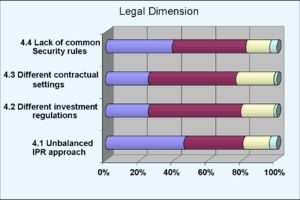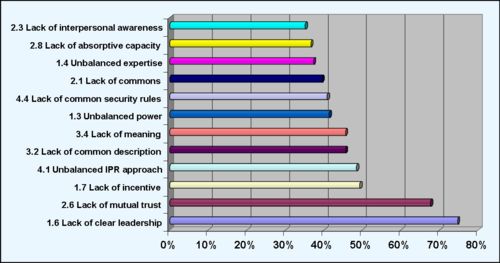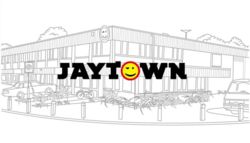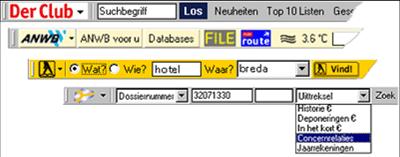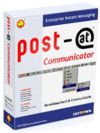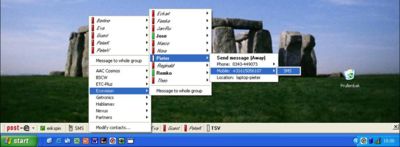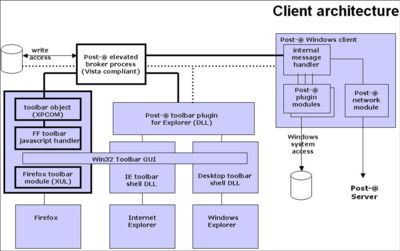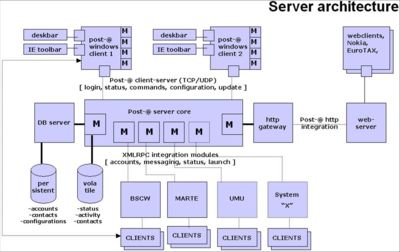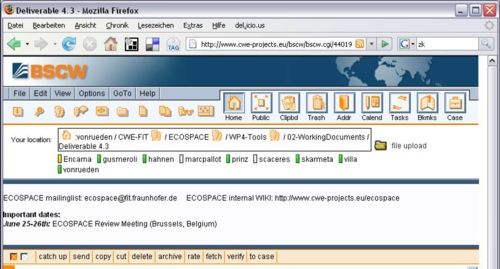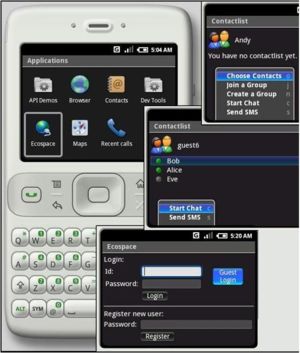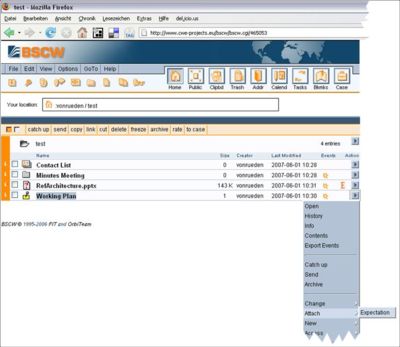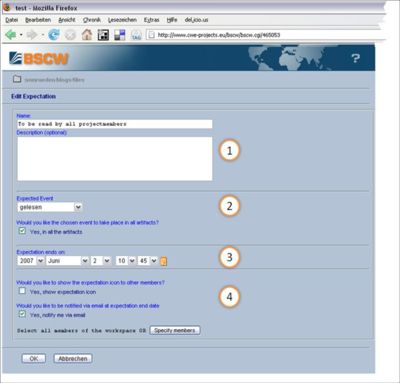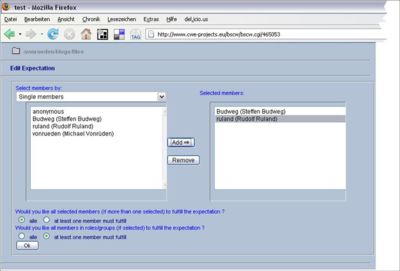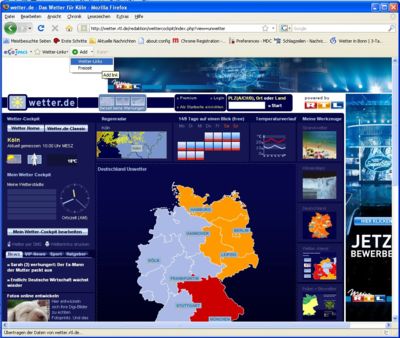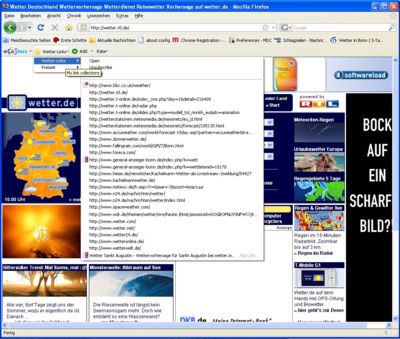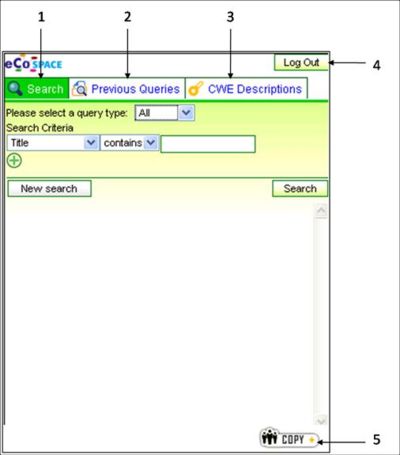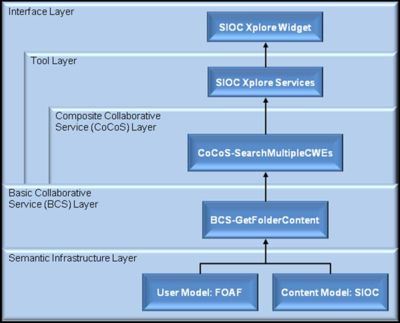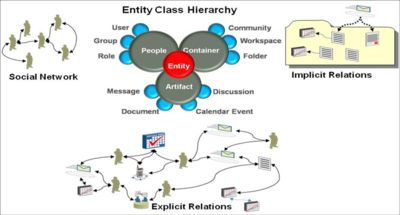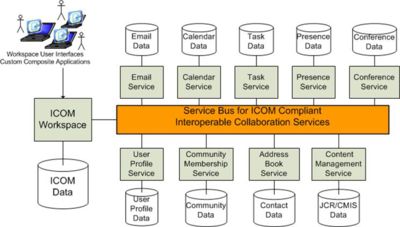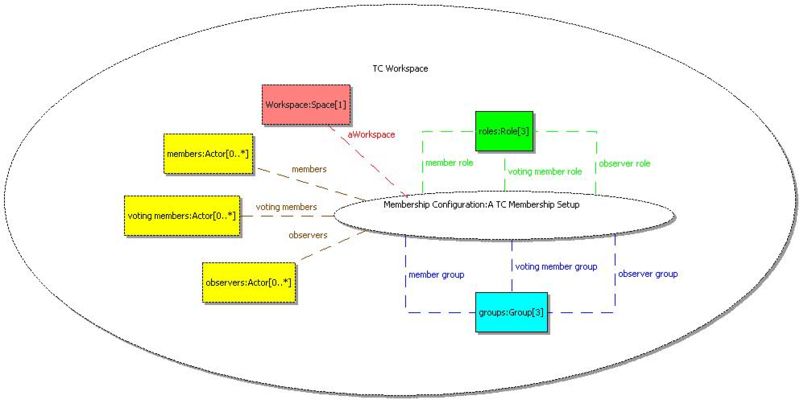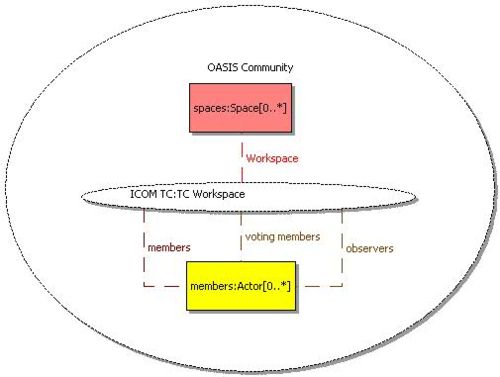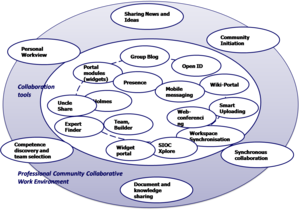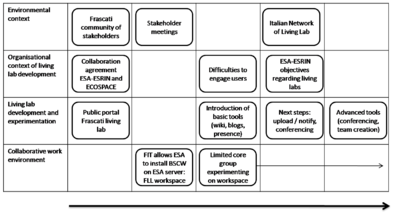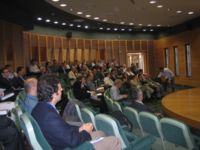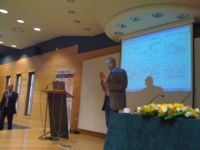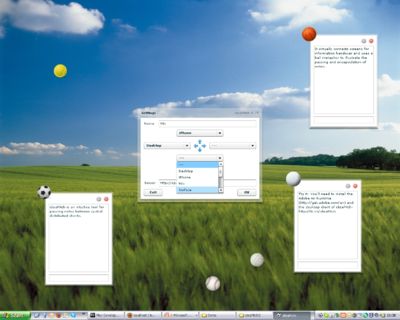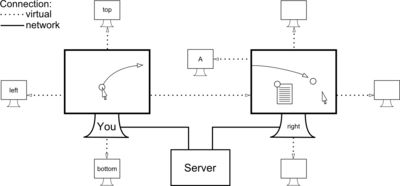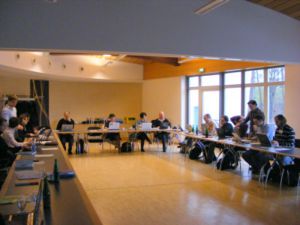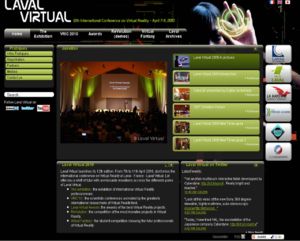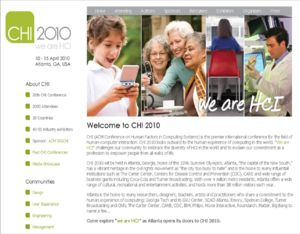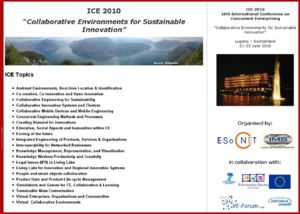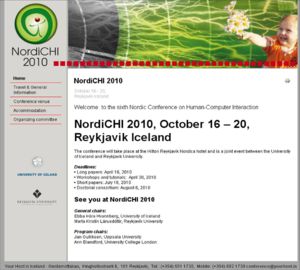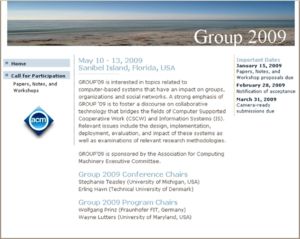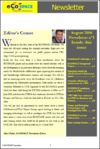ECOSPACE Newsletter No 11
From AMI@Work Communities Wiki
[edit] Editor’s Corner
The ECOSPACE project is officially ending on the 31st of October 2009, hence this is the final issue of the ECOSPACE newsletter before we leave you in peace...with your most favourite online collaborative platform. In fact this is a double issue n°11 & 12 dedicated to both CWE and Living Labs as it was initiated with the first double issue n°7 and 8.
Inside this double issue, you will find an article presenting the results of the survey on collaboration barriers, carried out by the ECOSPACE project, followed by an article describing a set of collaboration tools (Post-@ Communicator, Workspace Awareness, Mobile application and Collaboration Gateway, Expectation Awareness, Toolbar, SIOC Xplore Widget, and Sharing Support) developed or enhanced within the ECOSPACE project. As a continuation of the previous double issue, there is an article going inside the standardisation activity for Interoperable Collaboration Services that should enable, in the near future, Service Front-End (SFE) platforms where users will be able to compose their collaborative services according to the needs of every specific working context.
You will find also articles about Living Labs methods and new development such as the announcement of the ENoLL 4th Wave of Living Labs and a new project, named APOLLON, which was recently launched under the Competitiveness and Innovation Framework Programme and ICT Policy Support Programme, as well as the article about the serious gaming initiative for identifying valuable collaboration services that could be shared among Living Labs, namely CS4LL Prediction Game.
This double issue includes also several articles reporting about various events where the ECOSPACE project was involved in organising and/or participating to specific workshops during the last six months.
As usually, the announcement of up-coming events, related to both CWE and Living Labs, is closing this double issue. However, we take this opportunity to provide a recapitulative list of all published ECOSPACE Newsletter issues as well as a list of produced ECOSPACE videos.
ECOSPACE, in his life-time, has conducted two surveys, one on emerging trends and one another on collaboration barriers as well as an empirical study on distance factors affecting collaboration efficiency and effectiveness that contribute to the body of knowledge in the area of collaborative environments.
Beside several specific collaboration tools (as reported in the newsletter issue N°4 article and in this issue) developed or enhanced during the ECOSPACE project for constituting an interoperable collaborative environment, a number of major elements were also developed and reported in previous issues of the ECOSPACE newsletter ( see the complete list), such as:
- CDF: a Collaborative Distance Framework based on a holistic view for disentangling distance factors (a specific scientific article is going to be published in the International Journal on eCollaboration - IJeC);
- CERA: a Collaborative Environment Reference Architecture;
- BCS: a set of Basic Collaborative Services which constitutes the first stone towards interoperability;
- CoCoS: a process over the BCS layer for assembling various tasks into Composite Collaborative Services;
- SIOC4CWE: the extended SIOC ontology for supporting the description of elements belonging to Collaborative Working Environments;
- D2C: the Distributed Document Context for making transparent objects location;
- CWE Widgets: a set of Web gadgets allowing users to build-up their on CWE portal or dashboard.
Some of the used concepts have already been contributed to standardisation initiatives (W3C, OASIS ICOM TC).
ECOSPACE partners have built a considerable amount of knowledge and experience on the openness and interoperability of Collaborative Environments and Services in bringing together the social (Web2.0) and semantic web towards the collaborative web (Web3.0). ECOSPACE results are contributing to the work of the OASIS ICOM Technical Committee for designing a standard that will enable the interoperability of Collaboration Services (see the specific article below). Hence, it will enable a global ecosystem for eCollaboration developers and users where everyone will be able to compose his Collaborative Environments and Services according to his needs within every specific context.
ECOSPACE was also concurrently exploring the potential impact of the Living Lab approach in order to involve users at the earlier stage of R&D for contributing to the co-creation and exploration of innovative ideas, scenarios and concepts embedded into technological artefacts that are prototyped, experimented and evaluated through successive user experience cycles. The Living Lab approach appears to go a step beyond more traditional User Centered Design (UCD) models and approaches (e.g. cooperative design, participatory design or contextual design) towards User Co-Creation in turning users from being traditionally considered as observed subjects (e.g. behaviour and usage analysis) into content/value creators. There are examples where users are co-creating such as crowdsourcing, predictive markets (see the book entitled "The Widsom of Crowds"), Collective Intelligence, Collaborative Filtering that are illustrating stigmergy, swarn intelligence or even mass collaboration(see the Wikinomics book) as being online collaboration paradigms.
Let's hope that the up-coming FP7 ICT Work Programme 2011-2012 will include the promising vision of the Collaborative Web Environment (Web3.0) and the Living Lab approach as being two of the essential research objectives for the development of the Future Internet by and for users.
Last but not least, I would like to thank all partners for their invaluable contributions to the success of the ECOSPACE newsletter as well as some kind readers for their encouraging messages and more particularly Rudolf Ruland, Fraunhofer-FIT, for his constant and friendly support in producing and distributing the newsletter issues. We also acknowledge the financial support of the European Commission and inspiring recommendations of our Project Officer and his review team.
I could not resist to invit you to play with the "CS4LL Prediction Game" and to attend the annual ESoCE-NET Industrial Forum, to be held in Rome on the 7th of December 2009, to see the latest developments in the area of Collaborative Innovation and Living Lab!"
[edit] Coordinator's Message
The end of a project is the natural point in time to look back at the projects achievements. I am pleased to say that ECOSPACE yielded a number of results that will remain relevant also after the project and that will have continuous impact on Collaborative Working Environments (CWE):
- The project delivered a number of new and innovative collaboration tools. These include tools that aim at the analysis of social networks that emerge within CWEs, that apply new awareness concepts (such as the ones described in this newsletter), or that change the way groups initiate, manage and follow-up meetings. Furthermore, a number of tools have been developed that show the integration of different collaboration concepts, such as the seamless combination of messaging and sharing tools to overcome the flooding of email boxes. The mobile worker is supported by mobile applications that provide transparent access to the underlying collaboration platforms. New and innovative interaction methods have been applied by recently developed collaboration tools that deliver a seamless interaction between a user's desktop, iPhones and a multi-touch table (MS-Surface).
- An initial vision of ECOSPACE was the provision of an integration concept for CWEs. We have achieved that vision by the development of a reference architecture that is based on state-of-the-art service oriented architectures and semantic layer as well as Web 2.0 concepts, and that provides a lightweight integration and interoperability approach using W3C standards like SIOC. Based on this architecture we were the first to demonstrate the interoperability of shared workspace systems from different vendors (ICT 2008 exhibition). We believe that both, the concept and the implementation pave the way towards cooperation interoperability beyond the simple traditional email exchange.
- We are very happy to say that the OASIS ICOM initiative for the development of an integrated collaboration object model for interoperable collaborative services took up concepts of the ECOSPACE reference architecture.
- Most of the requirements for our developments originate from close interaction with several living labs and they also have been experimented and evaluated in those real life contexts. We are pleased that Living Labs have been using ECOSPACE developments during their daily work and that some will continue using the ECOSPACE CWE even after the project. Our close interaction with living labs resulted in the development of a living lab handbook that has been made available online.
- The AMI community has been an important part of this Living Lab since ECOSPACE has supported this community by the provision of ECOSPACE tools and services over its lifetime and will do so in the future.
- ECOSPACE has been successful in disseminating it research results to the academic community which resulted in numerous conference papers as well as two edited journal special issues on CWE.
- Some of the ECOSPACE developments have reached already a maturity level such that they have been already been concurrently integrated into new product versions of BSCW, BC, VE-Forum, Post@, and Marte. Thus the exploitation of the project results took already place during the project life.
Finally I wish to thank all project and Living Lab partners for the excellent contributions to the project and the enjoyed and successful cooperation during the project. I'm sure that not only the project results and accumulated knowledge will last for a while together with the trusted collaboration relationships that will lead to innovative ideas for future research projects as well as scientific contribution to the preparation of future ICT work programmes.
[edit] ECOSPACE Survey on Barriers Affecting Collaboration Effectiveness and Efficiency
[edit] Survey Introduction
Nowadays, it is widely recognised that a number of various factors are affecting collaboration effectiveness and efficiency. Those factors are creating different types of distance among collaborating people such as eProfessionals. A recent literature review has allowed us to identify a number of factors grouped into twenty factor types or classes that are tentatively clustered into an overall concept named "Collaborative Distance". This overall concept of collaborative distance has four dimensions in order to distinguish structural, social, technical and legal aspects. Collaboration barriers are generated by factors creating different types of collaborative distance impacting significantly collaboration effectiveness and efficiency.
A survey on collaboration barriers, carried out from June 2007 to June 2008, was intended to collect respondents’ views about a number of collaboration barriers based on their own experience forged during previous collaborative projects. Each assertion included into the questionnaire identifies a potential barrier which implies a certain negative impact on collaboration performance.
The question that respondents were requested to answer was: "Do you believe that this assertion is corresponding to a collaboration barrier which has a negative impact on collaboration performance?"
Respondents were requested to tick only one of the following possible answers:
- Major impact: This is a collaboration barrier having a major negative impact on collaboration effectiveness and efficiency.
- Average impact: This is a collaboration barrier having an average negative impact
- Minor impact: This is in somehow a collaboration barrier having a minor negative impact
- No impact: This is definitely not a collaboration barrier!
The "no impact" choice means in fact that respondents believed it was definitely not a collaboration barrier. Collaboration barriers included in this survey are corresponding to various distance factors as previously discussed in the literature review. These collaboration barriers or distance factors were grouped into four dimensions corresponding to the collaborative Distance Framework: structural, social, technical and legal dimensions.
The applied website approach for posting the survey is composed of complementary polls. In fact, the survey is built of four polls, one for each dimension. This approach provides a lot of flexibility to respondents as they can start expressing their opinion for one poll and then pause for a while if they need to. Later on, they can resume in expressing their opinion with another dimension or vote for several polls during the same visit. The main objective is to make sure that respondents do not need to spend too much time at once for completing the whole survey. Furthermore, current resulting vote figures are always available without imposing to respond to the survey for getting access to them. It means that there is no risk of having participants dropping fake responses in the survey just to get access to the resulting figures.
This is considered as a valid approach to avoid low quality responses as only motivated people are participating to the survey. However, it should be noticed that another interesting added-value of conducting on-line survey through community website polling is the quite immediate shaping of the resulting figures to foresee, in somehow, the community opinion regarding some specific aspects.
There were, at that time, more than 2000 registered members on the AMI@Work communities’ website where the survey was posted. Most of the members are experienced researchers, developers and engineers. This online survey has got a maximum of 82 respondents for the structural dimension (see figure 1). Resulting figures appearing on the web pages have got more than 4000 visits. The survey questionnaire includes 25 collaboration barriers based in fact on 25 distance factors that are grouped into 4 dimensions as explained above.
The following table (see Table 1) shows the full list of factors grouped by dimensions and resulting estimated impact levels that were rated by respondents. In term of choice for rating the estimated impact level, respondents had the choice amongst the following options, namely: major, average or minor impact and no impact at all. The option named major impact was corresponding to “most significant impact” while the option “average impact” meant “significant impact” and finally “minor impact” meant “less significant impact”.
For sure, the last option named “no impact” meant in fact that a mentioned factor was definitely not a collaboration barrier as it was considered as not affecting collaboration performance. Fortunately, this case of selecting the option “no impact” did not get a significant number of votes (ranged in between 0 and 7) which revealed that all included factors were most certainly corresponding to real barriers. It should be noticed that all included barriers or factors are coming from the conducted literature review.
In the following sections, resulting votes are presented by dimension with a cumulated view for each factor where major, average, minor and no impact votes appear on a same bar with different colours. This kind of cumulated bar graph representation provides a direct view on the repartition of votes.
[edit] Structural Dimension
The following legend showing the colours repartition for each possible vote is voluntarily not repeated along the four dimensions as it is always the same used colour code.
In the structural dimension, seven potential barriers or distance factors were included. The most famous one, from a literature point of view, is the geographical dispersion of collaboration participants which is often named distributed groups or virtual team (no physical collocation) – creates spatial, organisational and institutional distance. The second one corresponds to collaboration participants or team members operating from different time zones or flex time mode (variable work schedule) – creates temporal, organisational and institutional distance.
The third one represents an unbalanced power in decision making which may happen in the well known case of hierarchical driven process (the boss is always right!) – creates organisational distance at distributed power level. The fourth one, unbalanced expertise is also a well known case of decision committees where all necessarily involved disciplines in the daily work are not participating to the decision making (e.g. product life-cycle consideration) – creates organisational distance at expertise level.
The following one on multidisciplinary setting refers to the fact that the more participants and diversity involved imply management overhead and coordination burden – creates organisational distance. Then, the lack of clear leadership refers to a situation where no-one appears as leading the collaboration process – creates organisational distance with a serious limitation on shared vision, goals and objectives.
Last but not least, the lack of incentive means that the incitation for collaborating with others does not necessarily exist even in some cases it could be the reverse situation due to the worker’s evaluation mode used by the management (evaluating purely individual productivity and not at all interpersonal productivity) – creates organisational distance in limiting individuals’ collaborative willingness or attitude.
The above cumulated bar graph (see figure 2) presents the resulting figures for each proposed barriers in the structural dimension. It reveals that the lack of clear leadership has by far the most significant impact on collaboration performance followed by the lack of collaboration incentive. Unbalanced power and expertise in decision making were rated as having a significant impact as well as the multidisciplinary setting which induces management overhead and coordination burden. Noticeably, geographical dispersion was rated as less significant impact which reveals that respondents experience is showing that current available ICT support is satisfactory for overcoming this kind of barrier as well as for collaborating over different time zones. As the last one requires mainly asynchronous communication and interaction, it is even more considered as having a minor impact on collaboration performance. In contrast, distributed groups are not necessarily limited on asynchronous communication and very often use synchronous communication and interaction, either oral or written or a mix, which is still leading to more technological and cost problems. Though, nowadays, there exist free tools on the web (e.g. skype) with zero communication cost where it is possible to have a voice or video conference with group members.
[edit] Social Dimension
In the social dimension, height potential barriers were proposed to the survey participants:
- Lack of common usage and norms often due to different geographical areas, business or organisation cultures – creates cultural distance
- Weak ties among individuals – creates social distance
- Lack of interpersonal awareness – creates relational distance
- Multi-lingual setting – creates lingual distance due to interpretation as being a source of misunderstanding
- Emotional behaviour – creates emotional distance
- Lack of mutual trust – creates relational distance
- Diversity setting – creates cognitive distance and source of misunderstanding as each discipline has its own vocabulary
- Lack of absorptive capacity as being the ability to quickly learn and adapt in a short period of time – creates cognitive and learning distances
The above cumulated bar graph (see figure 3) presents the resulting figures for each proposed barriers in the social dimension. It reveals that the lack of mutual trust is by far having the most significant impact on collaboration performance. This is confirming the result of the literature review regarding the trust factor. Though, we did not find any relevant trust model for collaboration, either physically or virtually collocated group members, explaining the direct links with other distance factors such as weak ties and interpersonal awareness which were rated as having a significant impact. There could be a link also with the multi-lingual setting factor as people speaking different mother tongues, hence having different cultures, would not encourage a good level of confidence and trust. The lack of commons usage and norm together with the lack of absorptive capacity were, not surprisingly, also rated as having a quite significant impact on collaboration performance. The diversity setting was rated as having a significant impact as on the one hand it brings more creativity potential but on the other hand it brings also more cultural and cognitive distances impeding noticeably collaboration performance. In contrast, the emotional behaviour was not considered as a significant factor as it was rated as having a less significant impact. This might be explained by the fact that people feel more comfortable in situations with emotional distance, especially for individuals that are too shy.
[edit] Technical Dimension
In the technical dimension, six potential barriers were proposed to the survey participants:
- Lack of media naturalness (individuals cannot use all their natural senses to communicate such as face expression and gesture) creates cognitive distance.
- Lack of common description (e.g. concepts, references, taxonomy …) – creates conceptual distance.
- Multi-platform setting (e.g. type of devices, OS,…) – creates referential and technological distance.
- Lack of meaning – creates semantic distance.
- Unbalanced technological usage and expertise – creates technological distance.
- Lack of contextualised operational mode (context awareness) – creates contextual distance
The above cumulated bar graph (see figure 4) presents the resulting figures for each proposed barriers in the technical dimension. It reveals that the lack of common description (shared knowledge) together with the lack of meanings (shared sense-making) were both rated as having the most significant impact. This is also confirming the literature review feedback where it was found that shared knowledge and sensemaking constitute the essence of collaboration. The unbalanced technological usage inducing technological distance and the lack of contextualised operational mode inducing contextual distance were considered as having a quite significant impact on collaboration performance. Interestingly, the multi-platform setting was rated as being a less significant factor which may lead to the interpretation that survey participants are satisfied with the current level of tools execution whatever is the computing device and operating system in used.
[edit] Legal Dimension
In the legal dimension, four potential barriers were proposed to the survey participants:
- Unbalanced Intellectual Property Rights (IPR) approach – creates ownership distance
- Different investment regulations – creates financial distance
- Different contractual settings – creates contractual distance
- Lack of common security rules – creates confidential distance
The above cumulated bar graph (see figure 5) presents the resulting figures for each proposed barriers in the legal dimension. It reveals that the unbalanced Intellectual Property Rights (IPR) approach, inducing ownership distance, was considered as one of the six most significant factors. It is true that the wide range of ownership approaches standing from Creative Commons up to patenting makes difficult the diffusion of restricted and confidential information which in turn impede the collaboration performance. The different investment regulations and contractual settings, depending on the respective country policy where each distributed groups is located, as well as the lack of common security rules were considered as having a quite significant impact also impeding seriously collaboration performance.
[edit] Survey Analysis
Among the 25 collaboration barriers mentioned in this survey, there is a first group of 5 barriers considered by respondents as being the most significant ones having a major impact on collaboration barriers. Then a second group of 15 barriers considered as being significant barriers having an average impact and finally 4 barriers considered as being the less significant ones having a minor impact.
[edit] Major Impact Barriers
Looking at the resulting top 12 figure dedicated to barriers having a major impact (see figure 6) on collaboration performance; it appears quite clearly that three of them received an absolute majority of votes. Among them, two barriers, namely Lack of clear leadership (73%) and lack of mutual trust (65%), were considered by respondents as being the most significant ones by far.
The third one, lack of incentive, has also got an absolute majority of votes with 51% which is quite logical as it is conditioning the collaborative attitude of group members. In this survey, the lack of clear leadership was mentioned as a potential barrier contributing to the increase of organisational distance partly disabling shared purpose, vision, goals and objectives among distributed group members.
The lack of mutual trust was described as increasing relational distance, hence having weak ties among group members. Leadership and trust are abundantly mentioned collaboration factors in the literature. Lipnack and Stamps (1997) stated the following about leadership in team: “virtual teams and networks demand more leadership not less”. They also stated about trust in teams: “In the networks and virtual teams of the Information Age, trust is a need to have quality in productive relationships.” In the literature, leadership and trust appear quite often as conditioning collaboration effectiveness.
This is, most probably, due to the fact that trust has a greater impact on collaboration effectiveness while task & process leadership has a greater impact on collaboration efficiency. This resulting figure of the survey is confirming previous conclusions on the paramount importance of leadership and trust in distributed collaboration. Therefore, a good question for Collaborative Working Environments (CWE) researchers and developers might be: in which way ICT can support leadership and trust within a distributed collaboration? What is the most appropriate trust model for supporting eCollaboration?
Three barriers have got a relative majority as having also a major impact (see figure 6) but rather close to absolute majority as they are standing in between 50% and 44%, namely: Unbalanced IPR approach (46%); Lack of common description (45%); Lack of meaning (44%). Ownership (IPR) is quite rarely mentioned in relevant published studies while experienced people such as the survey respondents have been placing it in the top 4 most significant factors impeding collaboration performance. The lack of common description is corresponding to a lack of shared knowledge that could be easily combined with the lack of meaning that is leading to a lack of mutual understanding. Roschelle (2000) and others argued already that shared knowledge and meanings, which are conditioning the reaching of mutual understanding, are the essence of collaboration.
[edit] Average Impact Barriers
Fifteen barriers have got an absolute or relative majority, as having an average impact (see figure 7). Four of them have reached an absolute majority which means that respondents considered them as being quite significant factors impeding collaboration performance, namely: Unbalanced technological usage and expertise (56%); Different investment regulations (55%); Lack of contextualised operational mode or context awareness (51%); Different contractual settings (53%). The one on Lack of common usage and norms has got 50% of votes.
The ten remaining barriers in this group have got a relative majority, namely: Weak ties among individuals (49%); Lack of media naturalness (47%); Unbalanced expertise in decision making processes (46%); Lack of absorptive capacity (46%); Diversity setting (46%); Multi-lingual setting (45%); Multi-disciplinary setting (44%); Lack of common security rules (42%); Lack of interpersonal awareness (41%).
[edit] Minor Impact Barriers
Four barriers have got a relative majority, as having a minor impact (see figure 8). It means that they are considered by respondents as being the less significant factors impeding collaboration performance, namely: Individuals operate in different time zones or flex time mode (variable work schedule) creates temporal, organisational and institutional distance; Multi-platform setting (e.g. type of devices, OS,) creates referential distance; Emotional behaviour creates emotional distance; Geographical dispersion of individuals (no physical collocation) creates spatial, organisational and institutional distance.
Most of the respondents are most probably convinced about the implementation of flexible work arrangements such as remote working from home, travelling environment (e.g. train, plane, and hotel), and meeting place or event location. In fact, it has already started based often on the motivation of costs cutting and increases of productivity due to less wasted time with for example no need to travel everyday to the office as knowledge-workers/eProfessionals could decide to carry out their tasks from their home office, customers’ sites or even suppliers’ premises. This has a clear benefit for the organisation regarding space cost cutting, more mobility, and for employees on gaining more freedom in becoming self-organised. In fact a large majority of experienced people, such as the survey respondents, do believe that future online shared workspaces will better integrate social, learning, entertaining and work activities. In fact, flexible working time allows knowledge-workers/eProfessionals to have some breaks for social activities (e.g. chat with colleagues using VoI or IM), instant learning (e.g. searching for information) or just surfing on the Internet whenever they wish.
[edit] ECOSPACE CWE Tools
[edit] JAYTOWN Post-@: How the ECOSPACE project gave us a swing!
[edit] Introduction
Jaytown, official name SPIN! Media Technologies BV, was founded in 1997 as a multimedia software development company. Jaytown has developed a customer base in the media business domain (television, video, advertisements and communications agencies) as well as in the industry. In the beginning, typical assignments were to produce interactive applications such as CD-ROMs, sponsored computer games, interactive manuals, and websites.
The "smiley" logo represents the ease of use and straightforwardness of user friendly Jaytown products. From the onset, all earnings have been invested in product development, based on proprietary technology. This way, Jaytown became a specialist in toolbar technology. Toolbars are custom built, "widget like" client-server applications with an interface in well-known browsers such as Internet Explorer, Firefox or on the Windows desktop. They may appear with a simple interface, but the technology under the hood may be quite complex. It is a real field of expertise, since its development is quite complex, elaborated and depends on C++, win32 and even machine code development. There are very few software houses specialised in toolbar development around the world.
Jaytown toolbars are being used by hundreds of thousands of end users. Example of customers are amongst Yellow pages, KPN, UPC, ANWB, GfK, BBC, Nedstat, Fortis and Dutch chambers of commerce.
[edit] Post-@ Communicator
Since 1999, a group of informal investors provided additional funding enabling the development of a toolbar based product that is still being refined and developed today: Post-@ Communicator. Post-@ is an easy to use presence and instant messaging system for companies, closed groups or communities. An essential feature is that Post-@ detects keyboard or mouse activity of colleagues so to provide instant feedback on their status and availability.
Jaytown income comes from 2 sources: licensing and support for Post-@ Communicator installations and income from tailor-made toolbar applications (software development). Both are referred to as being based on "Post-@ technology", our powerful proprietary communication software library.
The market for Post-@ Communicator consists mainly of small and medium sized businesses who work in a distributed mode from different locations. The product is positioned as an inexpensive and reliable alternative to Microsoft Office Communicator and IBM Lotus Sametime. The ultimate challenge for Jaytown is to be engaged into a major licensing or distribution program with a strategic partner having access to the mass market of consumers and small businesses. It would generate the high return on investment Jaytown is now looking for.
[edit] Post-@ Communicator properties
Features
- Multiple clients (desktopTB, browserTB, PDA)
- Fully automatic activity indication
- Instant messaging
- Unique interface; very easy to use
- Branding and customisation possibilities
Technology
- Proprietary Windows server, modular architecture
- Lightweight "connection-less" protocol
- Remote configuration of clients, auto updates
- Tailoring through extension modules
[edit] Post-@ Communicator and ECOSPACE
Thanks to the ECOSPACE project, Jaytown has been able to focus more on integration R&D of the Post-@ system. As a result the software has undergone considerable reengineering, improvements and new developments. Many things under the hood have been revised and innovated, to enable integrations in the ECOSPACE CWEs and to allow for the type of scalability that is essential for open integration. It took heavy experimenting and some groundbreaking work to find solutions for problems that no-one seemed to have encountered before.
Some of the developments that Jaytown has been able to implement in the scope of the ECOSPACE project are:
- Dynamic, server based configuration and updating of Post-@ clients
- Several authentication and encoding features for connection and integration
- Integrations with BSCW and other ECOSPACE partners’ tools (e.g. Marte, TXT workflow)
- XML/RPC and Webservices/SOAP based integration on server level
- Multithreaded server core with multiple client handling and fast DB lookup
- State of the art technology for multiple, concurrent integrations (server modularity)
- Realtime status exchange and synchronisations with attached external systems
- Modular add-on architecture for “Best of Breed” combination with other systems
Some new ideas
ECOSPACE has opened up Post-@ for integrations and it has opened up the company as well for new opportunities. Jaytown is now looking at ways to convert the powerful new properties into some “lighthouse” products. These should more clearly distinguish the value of Post-@ technology and enable Jaytown to find strategic partnerships. For this type of partnership, the integration with Post-@ should offer a sustainable competitive advantage. Two example ideas at this stage are:
- Presence Hub: An "Umbrella" type of presence service, comprising the status of multiple attached systems. The Presence Hub (based on Post-@ Server) would be aggregating the presence and activity status from users on each of the attached (external) systems; making this status available through a Webservice (subscription based). There is also an optional, easy to use client interface (toolbar) for end users. This would provide real-time insight into the presence, availability or activity of colleagues or project members on central web interface or desktop client.
- Community alert: An online community might offer a branded Post-@ toolbar client application to their members. The community’s web server gets real-time presence and activity information (including webpages currently visited) from its member from the Post-@ system, through the Webservice interface. This way, members may be alerted through the toolbar when other members visit certain webpages (in or outside the community). Members can communicate securely with each other, even without a browser. This enables alerts or messages to be sent when a particular person would visit a certain page or engage in some kind of online activity.
General benefits for ECOSPACE
The Post-@ server is a reliable presence, IM & alerting component (99,99%) that other tools or systems may use and integrate with, using it to facilitate synchronous communications and session setup.
After the project
Jaytown continues to offer an "ECOSPACE compliant" presence Webservice & API and will develop mature integrations with existing and new partners.
ECOSPACE shines a light on new strategies for Jaytown. Web 2.0, the semantic web, online collaboration, professional communities, social networks, this is the area where Jaytown is heading with product development. Offering online services based on Webservices will be a future business model for Jaytown. A possible offering would be a Webservice based Presence ASP service in combination with branded toolbars. With this we would target public / consumer / B2C markets. The idea is to establish partnerships with entities having a very large customer base and willing to implement a community tool or service delivered by Jaytown. In the near future, this should give access to markets with economy of scale (low operational cost; fast growth, repetitive income).
Besides a connection or installation fee and optional investment in customisation, the customer - that could be in fact a community - would receive the service for a small yearly amount per active user/member. It generates more value for end users and lowers churn rate. New features would enable new revenue streams, for example targeted advertising, sponsored IM messages and so on. Jaytown hopes to secure additional funding for the development of services like this in 2010 and to reach profitability with it in 2012.
Taking part in the ECOSPACE project has facilitated Jaytown to proceed with investing in its technology and has provided it with lots of new development ideas. We are further inspired for the future. We are thankful for that to the ECOSPACE project and partners, hence to the European Commission!
[edit] ECOSPACE Workspace Awareness
To extend the asynchronous shared workspace system (i.e. BSCW, BC) by a synchronous component (i.e. the online status of the members in a workspace) integration with the presence and instant messaging system Post-@ Communicator was implemented. Here the shared workspace tool (BSCW) connects to a Post-@ server to get the presence status of the members. On the other side the Post-@ Communicator shares the BSCW user database and imports BSCW member lists, such as the personal BSCW address book or the members of special BSCW workspace groups.
[edit] Description
The Post-@ Communicator defines the following presence status:
- available and active
- recently active
- inactive
- unavailable
- don’t disturb
BSCW shows members'status of the current workspace as a kind of toolbar
(see Figure) below the navigation line. By clicking on a user name one
can send this user an instant message. The toolbar itself can be toggled
by the display status:
- Hide: don’t show the toolbar
- Show online: show only members which are connected to the Post-@ Server, i.e. not unavailable
- Show all: show all members of the workspace
Post-@ synchronizes its user database with BSCW. On login it imports the personal BSCW address book of a user as a special BSCW group in the Post-@ contacts. Members of BSCW workspaces can also be imported as Post-@ contact group. A menu for quick access to the BSCW workspaces in the user’s home directory is offered.
[edit] Functionality
- BSCW queries Post-@ server for presence of members of a workspace.
- BSCW includes online status in user interface (using symbol, text or colours)
- BSCW allows to contact Post-@ users from BSCW GUI
- If the sender is connected to Post-@ then his Post-@ client is used for IM (in Internet Explorer only).
- If the sender is not connected to Post-@ then BSCW provides a web form to send IM
- BSCW and Post-@ share login names and password. BSCW leads.
- Post-@ client contact list is fed from BSCW address book
- Post-@ shows BSCW button with a list of workspaces
Workspace awareness supports the requirements Activity Space and
Synchronous Communication and Collaboration. It is a bridge between the
asynchronous working with documents in workspaces and the synchronous
communication among the members.
The implementation of the workspace awareness can be regarded as a
CoCoS. On the BSCW side base line tools like GetPresenceState and
SendMessage are used, while the Post-@ Communicator invokes base
services like GetUserConfig and Synchronize.
[edit] Benefits
The workspace awareness enables presence in the context of work. It extends the document centric approach of a Shared Workspace tool (i.e. BSCW, BC, Netweaver) with a people centric approach. It further enables immediate communication with cooperation partners from the context of work and integrates presence in different systems.
[edit] ECOSPACE Mobile application and Collaboration Gateway
[edit] Introduction
Support for ubiquitous collaboration is one of the overarching goals of ECOSPACE. For example, consider technologies for presence status, notification and messaging. Currently, groupware includes proprietary support for these technologies, largely lacking interoperability, lacking support for multiple devices and built-in ways to extend the functionality across applications. Recently, more flexible solutions such as so called MultiMessengers appeared, which allow for messaging across different platforms. The integration is still proprietary and cannot be extended or modified easily. ECOSPACE suggests semantically-enabled openly standardized basic collaborative technologies and CoCoS (composition) to solve these problems.
Additional challenge arises due to existence of different technological and organizational infrastructures. In business settings, concerns about security and similar issues have to be taken into account. Many corporate eProfessionals cannot use existing software to communicate with their behind-the-firewall colleagues, because the corresponding use (including common platforms such as Skype or MultiMessengers) is forbidden by company policies. Flexible design of alternative solutions can help to leverage different communication platforms and devices.
Last but not least, to be prepared for large-scale future collaboration scenarios envisioned in ECOSPACE, many collaboration channels should be seamlessly supported. Currently, linear combinations of means of collaboration (corporate emails, corporate calendar, IM, voicemail) are provided. Unfortunately, they do not provide sufficient support for ad hoc user-friendly collaborations with customers, colleagues, external partners and private network members, especially given the fact that the people come from different countries, have different affiliations and different technical means of communication at their disposal.
A promising approach is to follow the ECOSPACE Reference Architecture and to provide technically separated solutions for, first, back-end integration and non-functional requirements and, second, end-user oriented client platforms.
[edit] Requirements and Motivation
Mobile application and Collaboration Gateway is especially focused on support for eProfessionals on the move. The mobility aspect becomes more and more important for eProfessionals, in particular in corporate environments. It has been estimated, that there are 800 million professionals with mobile devices worldwide and that number will grow to one billion by 2010. Mobile application and Collaboration Gateway demonstrates prototypical support for multiple mobile client platforms, such as J2ME devices, Android platform, RIM devices. It provides basic functionality for mostly synchronous collaboration. A large part of the application implements support for communication based on the XMPP protocol, which is itself an open standard. Users of the mobile application can see the presence status of the members of their contact list and exchange messages with them. Several supplementary functionalities have been implemented to test the possibility of their integration with the described major functionalities. The supplementary functionalities only work for special use cases as they were intended for technology tests only.
The underlying user management and other infrastructure capabilities are provided by the collaboration gateway component. In a productive environment, it would be focused on providing business mobile services or on representation of a specific community and support for ad hoc cooperation with external systems and communities. The gateway is responsible for dealing with security concerns and other functional and non-functional requirements.
Developments related to Mobile application and Collaboration Gateway included several requirements-driven re-engineering efforts. The experience led to detailed understanding of the underlying technical complexity. Due to the complexity, it was not possible to provide end-user ready deployment with the available resources, but many aspects (interoperability, BCS, CoCoS, mobile UI etc.) important in the context of ECOSPACE could have been considered. Several scenarios such as Innovation Communities Demonstration Scenario and Presence Integration have been addressed and many others are possible with relatively little effort.
[edit] Functionality
The first deployment scenario of the application targeted the Android platform, recently introduced by Google. At the time of the development, emulator-only version was available and the corresponding SDK was in its early stage. On the other hand, we could to some extent profit from native support for XMPP communication. The messaging client provided for common functionalities for exchange of instant messages and allowed to see the presence status of the users on the contact list. One highlight of the application was CoCoS-based support for guest users, which do not have to register with the system but only get limited access to the mobile-access workspace. The “guest login” button lets the user directly participate in the discussions. In the background, several basic services such as anonymous login and selection of the default contact list are being invoked.
Another highlight was more detailed consideration of the ECOSPACE UserManagement basic collaborative technology (BCT). Proof of concept of the user and group management as suggested by Ecospace has been implemented, but any similar service-oriented technology could have been used. The next deployment scenario focused on J2ME-enabled devices. Apparently, the user interface had to be designed anew, but service interfaces could be reused.
The highlight was the introduction of the Email integration. It enabled support for an additional ECOSPACE basic technology. The proof of concept is exemplified in the figures above. The Email service could be prototypically integrated with the Messaging functionality, providing additional CoCoS examples. In particular, a user can start synchronous communication with the user, she is currently writing an email to. The other way around, one can directly access Email composition from the IM component. The prototype allowed to fetch a limited number of emails from the server at a time and to get the full text on demand. Such kinds of functionality currently require substantial investments and we present ways to reduce the costs (due to flexible design based on simple interface definitions) and to develop non-standard extensions.
The last deployment focused on RIM devices. In this case, we exemplified cross-organization cross-technologies collaboration. We decided to choose a lightweight implementation of the user management and to concentrate on the integration with other partners and technologies. Therefore Email service is not functional in this version, but can be easily reintroduced. The simple user management is integrated with that of a partners’ tool JammesWM. Both applications have access to the same XMPP Server maintained by ETRA (instead of the own previously used OpenFire Server installation). We demonstrated the Presence Integration live. The users in the left figure stem from the partner’s server. Apart from the described integration, further integrations are possible. The recently agreed ECOSPACE basic service GetPresenceStatus has been implemented, so that other partners can query the status information of the Mobile Collaboration Gateway. Vice versa, the described application could be extended to show presence information of other partners such as that of users of Marte video conference functionality.
[edit] Application Scenario
Mobile application and Collaboration Gateway is primarily intended for real-time collaboration support. The corresponding scenarios include support for ad hoc communication requirements, for example, as a new team is being set up. Ubiquitous synchronous communication, integrated with other means of collaboration, is another scenario.
Additionally, due to use of Web Services and other interoperable solutions, users of different platforms can be connected. They can make the first contact using the prototype. The seamless integration is facilitated by use of appropriate service compositions, which automate log-on process or aid switching between means of communication. Further scenarios can be configuration of personal settings or certain notifications, which can be easily implemented as new services provided by the server and do not require additional infrastructure.
Most important is the mobility aspect. It addresses the ECOSPACE goal to provide flexible, mobile and ready for ad hoc communication working environments. Mobility can provide added value for most collaboration scenarios.
[edit] Benefits
First, the prototype shows the value of different ECOSPACE concepts, both for developers and for end users. Service Orientation helps to clearly structure, modify and maintain the functionality. It allowed to essentially develop several similar but different applications, without the need to start from scratch every time. Use of semantic standards and agreed interfaces (potentially, further standards or common ontologies) provides for “cheap” interoperability with other tools and technologies and consequently for advanced functionality.
For the end user, several mass-market mobile devices can be supported. Several technological platforms have been addressed, so that vendor lock-ins can be avoided. Mobility aspect of collaboration has been addressed. The tools provide support for eProfessionals as they are away from their desks.
Several scenarios have been considered that combine the values of partner systems and connect people with different organisational affiliations. Mash-up scenarios become possible, since the tool can be accessed and configured from outside (receiving messages being the simplest example), but it can also ask partner systems for additional information (such as remotely maintained contacts roster or non-native kinds of presence information).
Corporate settings challenge collaboration tools to be compliant with the corresponding rules and policies. Our developments confronted this situation and showed that such hurdles can be overcome, even though they require additional efforts.
[edit] ECOSPACE Expectation Awareness
[edit] Introduction
Expectation awareness is a new approach in the area of awareness in groupware by suggesting a conceptual model for defining expectations of actions in a shared workspace and for an automatic check and notification of fulfillment or non-fulfillment of these expectations. As an extension of the BSCW the expectation-awareness-component is completely integrated into the Web-GUI and enables the user to attach and define expectations about the future use of a shared object.
[edit] Functionality
An expectation, like any other object in a workspace, has operations that can be performed on it. The basic set of operations is:
- Creation,
- Viewing expectation details,
- Editing,
- Destroying the expectation,
- Viewing the fulfillment result,
- Automatic checking,
- Notification of fulfillment result.
The first five operations are user initiated, within which the first four are for managing expectations and the fifth operation is for obtaining the current state of the expectation. The sixth operation is initiated by a timer service, set to an expectation end time.
An expectation can be assigned to various BSCW-object-types, like folders, documents, notes, etc. To assign a new expectation to an object, the following steps have to be passed. The expectation-dialog is called by the default operation-handling-menu of the BSCW-Workspace (see the above Figure).
Then, the user will be guided to the edit expectation dialog, where settings for the expectation can be changed. The following details of an expectation can be changed in this dialog:
- The name of the expectation (see Fig. below, 1) can be changed to summarize the expectation. Furthermore it is possible to extend the expectation by an in depth description.
- The event which is expected by the author of an expectation (see Fig. below, 2). In relation to the chosen object, the user can specify different event-types, like a generic read-event or a complex add note-event. These event-types will determine the fulfilment of an expectation at a specified end-date
- The termination of an expectation (see Fig. below, 3) is not restricted. But the chosen date has to be after the creation-date of the expectation.
- The user can specify the visibility (see Fig. below, 4) of the expectation to other users (private/public) and can address a group of users to the edited expectation. This is done in a sub-dialog (see Fig. below 6), where the user can combine single users, roles and groups to the audience of an expectation.
After adding an expectation to an object, there will be different expectation-icons displayed (see Fig. 7, right), where each refers to the state of either one or multiple expectations of an object. Table 1 provides a detailed overview about the different states of the expectation-icon.
These icons will change either by an explicit user-action, like reading a document or add some content to a note, or if the deadline of the expectation is passed. Because of the icon-color, it is easy for the expectation-author to track any changes. Moreover the original author will be informed by email at the end of the expectation duration-time. The email notifies the author about the fulfilment state of a special expectation.
| Icon | Color | Description |
|---|---|---|
| green | There are only fulfilled expectations on this object. | |
| red | There are only non-fulfilled expectations on this object. | |
| yellow | There are only ongoing expectations on this object. | |
| yellow-red | There are ongoing and non-fulfilled expectations on this object. | |
| yellow-green | There are ongoing and fulfilled expectations on this object. | |
| yellow-green-red | There are ongoing, fulfilled and non-fulfilled expectations on this object. | |
| green-red | There are fulfilled and non-fulfilled expectations on this object. |
Table 1: List of Expectation Status
The expectation-awareness component of BSCW enables, for instance, that project-coordinators are able to keep track of ongoing work in a (distance) working scenario. This is deeply related to the ECOSPACE-requirements. Moreover, the expectation-awareness component permits a coordinator to measure, either public or private, the working-effort of cooperation-partners in an informal way. This fits to the requirement to coordinate the work allocation and can act as an indicator for upcoming problems in a special section/workspace of project.
The requirement to enable a user to keep track about a special working effort of co-workers is represented in the graphical representation of the expectation-awareness-service in Fig. 8. As the expectation-awareness is currently a basic-service, which relays on the BSCW-Event-System and a scheduling-mechanism, the service is a building-block for the CoCoS “Expect Working Effort” which is an instance of the previous mentioned requirement. In conjunction with the CoCoS “Inform User”, this composed service allows to arrange a generic expectation to either a special object like a document or a generic expectation to a user or work-process.
[edit] Benefits
The expectation awareness allows users to monitor documents' status and the task progress. It is easy to enable "Notify me if X fails" awareness. Further it opens up a new field within awareness research "What is expected to happen". It frees the user from tracking the status of a document over and over again.
[edit] ECOSPACE Toolbar
[edit] Introduction
Teams and communities need gathering places. On the Web, for example, this could be a mailing list or a blog. The ECOSPACE Toolbar is a web-based solution that provides methods for social bookmarking to constitute the shared knowledge bases of teams or communities. It supports functions for cooperatively collecting, organizing, sharing and rating bookmarks. Information can be collected in private link collections or by a group of people in shared link collections.
The ECOSPACE Toolbar is based on the BSCW system and integrated as a toolbar in the Firefox Web browser. It shows how BSCW services can be integrated in browser extensions. For the interaction with BSCW and exchange of data it uses the SOAP protocol. Currently it supports German and English locale.
[edit] Requirements
Our users demanded for several means for cooperation. Shared workspaces, a shared knowledge base, and joint editing, support of collaborative information gathering and structuring. Additionally, an extendible glossary with important concepts that are relevant in the community fosters the common understanding. The possibility to rate information seemed to be necessary. This service provides an indication of the relevance of information to other community members. For web communities collaborative search in the Web should be supported, to avoid duplication of work. In addition, FAQs and newsgroups were required. Means to become aware about activity and presence of others are absolutely necessary, because they provide a context for the own activity.
Based on these requirements we designed and developed the ECOSPACE Toolbar.
[edit] Functionality
The ECOSPACE Toolbar is a web-browser add-on which makes social bookmarking in virtual teams and communities very simple and efficient. It accompanies users during browsing the web and assists to evaluate the quality and importance of content in the web. Users can create link collections, share them with others, or subscribe to existing common link collections. On the fly bookmarks with relevant content can be added to link collections. Whenever community member visits one of the collected web pages, the ECOSPACE Toolbar signalizes a direct hit. Then it offers community information and functions in the context of the current information, i.e. it indicates the link collection that contains the bookmark and the common members rating of the web page. If the visited web page belongs only to the same domain of an already collected bookmark, the ECOSPACE Toolbar indicates domain matching and gives the name of the according link collection.
The current design supports
- Creating link collections / subscribing to shared link collections
- Adding bookmarks to (more than) link collections
- Rating a bookmark / Indicating the common rating of all members
- Getting an overview of all collected bookmarks with the common rating
- Following collected links
- Matching of visited web pages against the bookmarks collected in subscribed link collections
All functions to the ECOSPACE Toolbar are available by buttons, menus, list items etc.
The integration of BSCW online features and tagging is intended in the future.
[edit] Application Scenario
“Creating a seminar paper on 'Weather Phenomena' ”
A working group consisting of three Students were assigned the task to jointly set up a state-of-the art study on a natural science topic: 'Weather Phenomena'. Those three agree on cooperatively collect the material. The ECOSPACE Toolbar will help them to organize, review and evaluate the information found on the Web.
In order to set up this collection Konrad installs the community 'Weather Phenomena' and invites Wolfgang and Sabine to join.
Now they can start to add Web links of interest for the study to this link collection.
In the course of a Web inquiry with Google Konrad first of all adds all the links with highest value for the study. Special beneficial pages are rated with a “good” attribute. This rating is seen by Sabine and Wolfgang in the collective link collection. They may rate the pages as well and by that they influence the result rating. Sabine discovers another study on the topic and she is informed by the toolbar that someone else has already investigated that page and has rated it “excellent”.
She as well thinks the contribution is relevant and rates it accordingly without adding the page again.
Konrad, Sabine and Wolfgang are very fast in collecting a bunch of relevant links. They are always informed when pages have already been added to the collection by colleagues and what their rating was.
Step by Step the working group opens up a variety of relevant documents and structures the material in the Web. Thus cooperatively and in a distributed manner they successfully integrate the collected material into the joint seminar paper.
[edit] Benefits
- The ECOSPACE Toolbar implements a tool for virtual communities.
- The ECOSPACE Toolbar is browser-integrated.
- The community members organize themselves.
- The community members jointly collect, rate and manage their information.
- Members recognize very fast if a collected web page has already been identified and evaluated by colleagues. Thus they avoid to do the work twice.
- The ECOSPACE Toolbar determines the relevance of websites for communities.
- The members’ activities are visible for the community and help to coordinate their cooperation.
- The Toolbar constitutes an extended community solution for web browser.
[edit] Integration
The ECOSPACE Toolbar is implemented as a toolbar for Firefox 3.0 or later in Javascript and XUL, an XML based language to build GUIs. It is based on the BSCW® groupware and interacts with BSCW by using the BSCW SOAP web services.
[edit] Summary and Outlook
Virtual communities come close to the fundamental vision underlying the World-Wide Web, creating information through cooperation and interaction among the community's members. Our ECOSPACE Toolbar adds powerful functionality for communication and cooperation to Web portals, thus helping active virtual communities to start and flourish. While communities may focus on widely varying subjects and serve a broad range of professional or private purposes, they all need easy-to-use tools for cooperative information management, i.e., for finding, gathering, evaluating, and sharing information on the Web.
Experiences with social bookmarking in the ECOSPACE Toolbar revealed that the context-based integration of community information and functions is a success factor for social interaction in communities. The access to community functions and the visualization of community information in the current working context of users enhances the spontaneous communication and cooperation.
[edit] SIOC Xplore Widget
[edit] Introduction
Collaborative Work Environments (CWEs) are shared workspace platforms, where eProfessionals may cooperate efficiently across the Web by storing, sharing, and managing files, appointments, contacts, and tasks. Examples of CWE platforms are BSCW, Business Collaborator (BC), VEA, NetWeaver, and Microsoft SharePoint. In current business activity, collaboration and cooperation not only takes place within a single organisation, but also increasingly between organisations; leading to projects being distributed over multiple workspaces or even over different CWE platforms. Additionally, eProfessionals may partake in multiple projects hosted on different CWE platforms. However, CWE platforms currently remain informational islands, with data expressed in a proprietary format coupled to each solution. Data cannot be exchanged or shared with other CWEs or other data sources, making it difficult to find and process knowledge.
The SIOC Xplore Widget aims to address this need, by enabling cross-CWE browsing and querying. Using the widget, relevant CWE data from a variety of CWE workspaces may be identified, retrieved, and merged, using a standard interface. Search results are returned in a common, semantic format, according to the SIOC ontology . This functionality alleviates the user from having to be familiar with a variety of CWE-platforms and it provides a single point-of-entry for cross-platform searching. The SIOC Xplore Widget is a web tool, which enables users to perform queries across multiple CWE platforms synchronously. This alleviates the load on users to be familiar with multiple CWE platforms and saves the time and effort that a user would have spent individually logging on to each CWE workspace, performing a search, and manually correlating the search results from multiple workspaces. This tool is currently integrated in the CO-LLABS Living Lab for evaluation purposes. The results of this evaluation process will be documented in [3]
[edit] Requirements and Motivation
The SIOC Xplore Widget acts as a single-entry point to data, originating in disparate CWE platforms. Interoperability issues arise, as each CWE platform expresses its data in a proprietary format. In order to facilitate data interoperability and enable the SIOC Xplore Widget to execute queries, correlate results, and present results to the end user, it is necessary to structure the CWE data in a homogenous fashion according to the Content Model of the ECOSPACE reference architecture [1]. In the case of the SIOC Xplore Widget, the adopted Content Model is based on the SIOC (Semantically Interlinked Online Community) ontology, which structures the data in a semantically interpretable format. The proprietary CWE data modelled according to the SIOC ontology, thus becoming interoperable with the data from other logical CWEs. Each of the legacy CWEs are required to export their data as SIOC RDF data through the use of SIOC Exporters. The SIOC annotated data is exposed through web services. The SIOC Xplore Widget may then execute queries in a common format across all SIOC data. For more information on SIOC and how it is used within ECOSPACE, refer to D3.6 [2].
[edit] Functionality
Adding the SIOC Xplore Widget to your Widget Portal
It was decided to expose the SIOC Xplore Widget as a widget, as a widget user-interface provides the following key benefits: syndication, flexibility, portability, and customisation. The widget can be accessed at http://widgets.cyntelix.com/siocxplore/Widget.html. Click on the icon at the bottom right-hand corner of the widget. The user is then given a selection of possible destinations for the widget, including Netvibes, iGoogle, Blogger, and Facebook. Select your desired widget portal and follow the directions on screen. Figure 1 shows the SIOC Xplore Widget embedded in an iGoogle webpage.
Registration & Login
In order to start using the SIOC Xplore Widget, a user must first register a username and password. Registration is required so that information corresponding to a user, such as CWE descriptions and query history, may be stored by the SIOC Xplore service.
Once registered, a user may log-onto the widget using his/her username and password in the login screen, as shown in Figure 2. A user’s session will automatically expire after ten minutes of inactivity.
Layout
An overview of the SIOC Xplore Widget layout is shown in Figure 3.
- Search tab: Searches are performed and search results are displayed.
- Previous queries tab: Previous searches carried out by the user are detailed.
- CWE descriptions tab: Descriptions of the user’s CWE workspaces are detailed.
- Logout button: Immediately ends a user’s session.
- Beemway copy button: Allows the widget to be copied to another widget-portal.
Search Tab
The SIOC Xplore Widget enables a user to query multiple CWE platforms using a single interface. The specified query is executed across data sourced from a set of CWE workspaces, those selected in the CWE Descriptions tab. By default all of the user’s CWE descriptions are queried. The SIOC Xplore Widget retrieves the data from the CWE workspaces in terms of the SIOC ontology. Therefore the search results, originating in heterogeneous CWE platforms, can be merged and presented in the widget interface in a homogenous format. The search criteria is analogous to concepts from the SIOC ontology. Figure 4 shows a screenshot of the Search tab.
- Query type: Specify what kind of object is being searched for: a container, an item, a user, or all .
- Search criteria: Specify criteria for search: title, creator, modifier, creation date, modification date, MIME-type .
- Add search criteria button: Add a criterion to the search.
- Delete search criteria button: Delete this criterion from the search.
- Search button: Perform a search.
- New search button: Start a new search.
When one or more search criteria have been defined, the user clicks on the ‘search’ button to begin the search. Results are retrieved from the appropriate CWE workspaces and displayed to the user in a homogenous fashion, as shown in Figure Information, such as name, creation date, and URL, is also displayed for the user’s benefit. He/she may link to the original item via the URL, or he may choose to be directed to the workspace containing the desired item.
- Title: Title of the result object.
- Creation date: Creation date of the result object.
- URL: The URL of the result object. This helps to identify the CWE workspace that this object originated in.
- Container link: If the result object is a container (e.g. folder, blog, etc.) a link to the container is displayed as part of the results.
- Item link: If the result object is an item (e.g. file, post, etc.) a link to the item and a link to the item’s parent container are displayed as part of the results.
Previous Queries Tab
The previous queries tab lists the last 20 searches that the user has submitted. If the user wishes to resubmit a query, he/she clicks on the query in the previous queries tab. He/she is then automatically redirected to the search tab, where the search criteria completed as per the original query. This saves time when executing commonly used queries. Figure 6 shows a list of previously submitted queries in the previous queries tab.
- Query ID: ID given to the query by the tool.
- Submission date: Date and time the query was submitted.
- Query conditions: The search criteria specified in the query.
CWE Descriptions Tab
The CWE descriptions tab contains details on the user’s CWE workspaces. A user may add a new CWE description, or edit or delete an existing CWE description via this interface. A user may only add a CWE description of a CWE workspace he/she is a member of, as user credentials must be specified for each workspace. Important to note is that the SIOC Xplore Widget is a cross-platform query tool, meaning that CWE descriptions of workspaces hosted on different CWE platforms may be specified. Currently BSCW, BC, and VEA are supported (see Fehler! Verweisquelle konnte nicht gefunden werden. for a full list of workspaces that are supported). Figure 7 shows a list of CWE descriptions that have already been added by the user.
- CWE workspace name: Name given to the CWE workspace by the user.
- Checkbox: If a CWE workspace is checked, it means that it will be searched across when a query is submitted in the search tab.
- CWE workspace URL: Link to the CWE workspace.
- Edit CWE workspace button: Modify this CWE workspace description.
- Delete CWE workspace button: Delete this CWE workspace description.
- Add CWE workspace button: Add a new CWE workspace description.
Figure 8 shows the pop-up window for adding a new CWE description or editing an existing one.
- CWE name: Arbitrary name given to the CWE workspace by the user.
- CWE URL: Link to the CWE workspace. Note, the id must be included in the URL, e.g. http://www.cwe-projects.eu/bscw/bscw.cgi/1538736
- CWE type: CWE platform that hosts the workspace, e.g. BSCW, BC, VEA.
- CWE username: User’s username at the CWE workspace.
- CWE password: User’s username at the CWE workspace.
The username and password are used to authenticate the user at the CWE workspace. The password is encrypted for security reasons.
[edit] Application Scenario
This scenario involves QueSystems Ltd., an IT company that specialises in developing large-scale, corporate IT systems. QueSystems has recently won a contract to develop a new payroll-system for the multi-national, medical-device company HospiCare. Technical planning is also currently underway. QueSystems has previously been involved in two related projects; project X involved creating a patient-payment system for a hospital and project Y involved developing a payroll-system for a multinational manufacturing company. Sarah, the CEO of QueSystems, decides to search the project workspaces of both of these projects to see what components were used in the system-architecture. However project X is hosted on the BSCW platform, whereas project Y is hosted on the BC platform. Sarah uses the SIOC Xplore Widget to search across both workspaces simultaneously. She searches for any items with the term ‘architecture’ in the title. A list of results from both projects are returned and displayed concurrently in the common widget interface. After a week, Sarah decides to check on the progress of two of her consultants. Patrick currently uses Business Collaborator (BC) to manage his collaborative work, whereas Anne uses the VEA Collaboration Suite. Using the SIOC Xplore Widget, Sarah searches across Patrick’s BC workspace and Anne’s VEA workspace for any items that have been created or modified in the past week. Many results are returned indicating that her consultants have been busy.
[edit] Benefits
The benefits of using the SIOC Xplore Widget are as follows:
- Efficiency: A user can query multiple CWE workspaces synchronously. This alleviates the user from having to log-on to each workspace manually, specify the query in the proprietary query interface, and correlate the results from multiple workspaces.
- Ease-of-use: A user does not have to be familiar with a CWE platform in order to perform searches across it.
- Portability: The widget can be embedded in any webpage or portal.
- Customisability: A user can add/edit/remove CWE workspaces as he/she wishes. They can also choose which CWE workspace to query.
[edit] Integration
The Collaborative Environments Reference Architecture (CERA) has been developed within the scope of the Ecospace project to support the design of Collaborative Work Environment (CWE) systems. CERA is a layered reference architecture that facilitates the design and development of interoperable CWE systems. The overall architecture consists of five layers. Figure 9 shows how the SIOC Xplore Widget complies with the CERA reference architecture model. In the following we will analyse the SIOC Xplore Widget’s compliance with CERA layer by layer:
- Semantic Infrastructure Layer: The SIOC Xplore Widget uses SIOC as its content model. All data is structured according to the SIOC ontology, which facilitates homogenous querying, merging, and presentation of CWE data from multiple, different CWE platforms. FOAF is used as the user model, providing a common representation of user information for users from all CWE platforms. As a result, users that are members of multiple workspaces can be easily identified. For the SIOC Xplore Widget, a context model and a process model was not necessary.
- Basic Collaborative Service Layer: The SIOC Xplore Widget invokes the GetFolderContent BCS. This basic service exposes CWE workspace data in the SIOC format. Many CWE platforms currently provide this BCS, including BSCW, BC, and VEA.
- Orchestration Layer: The SIOC Xplore Widget uses the SearchMultipleCWEs COCOs to retrieve the results of a specific query from multiple CWE workspaces. This COCOs accesses the CWE content via the GetFolderContent BCS, and then filters the data according to the search criteria of the query. The results are merged and returned.
- Collaborative Technologies and Tools Layer: The SIOC Xplore Service provides a service that records user profiles, including CWE workspace profiles and query history. This improves the user-experience and facilitates quick searching across pre-configured workspaces.
- Interface Layer: The SIOC Xplore Service is presented to the user as a widget interface, enabling it to be embedded on any popular widget platform or, indeed, on any website.
[edit] TXT Sharing Support
[edit] Introduction
TXT Sharing Support is a new tool, (composed by a set of CoCoS, services, ad-hoc plug-ins and user interfaces), featuring sharing support functionalities based on the concept of user-centric interoperability. The tool will help users to exchange knowledge and files in total transparency, based on their collaborative context, without taking care of the system or application they are using and irrespectively of the syntactic and semantic heterogeneity in which such knowledge has been represented and formalized.
TXT has designed and implemented two plug-ins to demonstrate different functionalities: an Outlook add-in (available for both 2003 and 2007 versions), to share e-mail attachments together with e-mail text, and a Microsoft Explorer extension, to browse the shared repository in a Windows-like style and accessing shared files and their meta-information.
[edit] Requirements and Motivation
Standard groupware systems provide several means for the sharing of working material: as attachments to emails or instant messages or through dedicated sharing applications (e.g. BSCW, Groove). However, this kind of sharing support is application and technology-centric.
What TXT Sharing Support is aiming to, is an “activity-oriented collaboration environment“, where users can organise their resources according to their processes, activities, teams and communities, based on a semantic integration of the cooperation activities as well as the services.
Such aspects require the management of interoperability issues. In this context “interoperability” shall not be considered amongst applications (i.e. “the ability of two or more systems or components to exchange information and to use the information that has been exchanged” - IEEE definition), but rather as “user-centric interoperability”, meaning "the ability of two or more workers to access and share knowledge, irrespective of users location, interaction devices and co-operation models, irrespective of the collaboration and applicative tools they are using, irrespective of the syntactic and semantic heterogeneity in which such a knowledge has been represented and formalized".
This tool is designed to support data-interoperability services, meaning that shared data can be automatically transformed according to the user's preferred format. In this way, the documents and messages exchanged within a project will no longer be scattered over the attachments of emails in email folders, the local disk and a shared file system or a shared workspace.
[edit] Functionalities
TXT has designed and implemented two plug-ins to demonstrate different functionalities: an Outlook add-in (available for both 2003 and 2007 versions), to share e-mail attachments together with e-mail text and a Microsoft Explorer extension, to browse the shared repository in a Windows-like style and accessing shared files and their meta-information.
- Outlook Add-in: this add-in creates a new toolbar in MS Outlook, which allows users to select one or more e-mail attachments to be shared in ECOSPACE and to provide context information. Thanks to a pop-up form activated by the “ECOSPACE Share” button, the user is able to choose the file(s) to be shared and to add metadata in a semi-automated way. For example, the email body, as well as the sender, receivers, etc. are information that is part of the metadata. The enhanced CoCoS architecture of the tool allows to easily integrate the add-in with any kind of DMS: in ECOSPACE it has been integrated with BSCW and TXT Polymedia WF.
- Explorer Plug-in: this plug-in for Microsoft Explorer allows users to access the shared repository as it would be a virtual drive mounted on the local machine, so they are able to interact with their own shared files and associated metadata, wherever they are, in the simplest way: resources will be shown according to the user collaborative context. The virtual drive appears under “My Computer” resources, labelled as “ECOSPACE Environment”, and provides access to data (optionally transformed according to the user's format) and the associated meta-information (i.e. the email body). Data are organized according to the user's collaborative context, and can be copied, updated, uploaded, moved, etc.
- Data Transformation Services: thanks to the CoCoS architecture, the tool offers a standard interface to generic data-transformation services (which can be supplied by third parties) and it is able to invoke them according to the user's context - meaning that the same file can be made available in two different formats for two different users.
[edit] Application Scenario
The tool is useful in every scenario where several people are interested in exchanging documents and e-mail is still one of the most common ways of interaction. The only condition to be ready to use the Sharing Support tool is to have Microsoft Outlook installed on the users PCs and have a DMS exposing Web-services for files upload (as BSCW or Polymedia WF).
In ECOSPACE we tested the tool in the De Agostini Living Lab, where communication between De Agostini people and external clients is often based on e-mail exchange, and results have to be considered very positive.
This addition to the system functionalities brought great advantages as:
- users external to DeA (clients, ad hoc experts, one time collaborators) not so used to the system interface or functionalities have been able to share relevant documents just by a couple of clicks in a very intuitive way;
- Outlook users had not any more the need to keep a local copy of the received e-mails, but they are now able to share the documents without using the Web browser, storing automatically all the mail metadata, as sender, mail subject and mail body together with the attachments;
- the shared documents and all the correlated meta-information are accessible only to people working on the specific project, process and task in which context the attachments have been stored.
[edit] Benefits
The Sharing Support is supposed to be a service rather than an application, and for this it could impact on end-users in several ways. In general, we can suppose its usage both in users’ legacy applications (i.e. GIS, mapping tools…) and in other ECOSPACE tools, whenever a sharing support is required. In the specific case of the Media Living Lab, there is a clear need of document sharing and exchange support, both in structured (workflow-like) and non-structured activities.
It has been possible to verify the benefits and impacts by:
- “ShareFile” CoCoS usage-statistics;
- efficiency during end-user processes execution, that is how these functionalities have helped them to perform their tasks in a more efficient way;
- quality & usability tests performed by end-users during their current working practices.
One hundred forty-six files have been shared through “ShareFile” CoCoS, the largest part of which happened during the Media Living Lab tests.
This tool brought several evident benefits to the scenario users. First of all it doesn’t cut e-mails out from the collaborative environment that is a key aspect nowadays, when e-mail is still the most used communication system, even for exchanging documents.
The proposed solution made sharing a document so much easier and faster: it was just a couple of clicks away, instead of having to save the attachment on the local drive, browsing to the DMS Web environment, going to the right folder, selecting the local file and manually upload the document, losing anyway all the references to the original e-mail information. Moreover users experienced a higher neatness in their local hard drives and repositories, because they are now able to keep only the server shared version and delete all the local copies of the files and the mail too, having all the information stored together with the attachment.
In the end, the tool has been improved under a usability point of view thanks to user feedbacks, which provided useful suggestions about how to make the software more easy to use.
[edit] Towards Interoperable Collaboration Services
This article is reporting about the current work carried out by the OASIS Integrated Collaboration Object Model for Interoperable Collaboration Services Technical Committee (ICOM) taking place within the Advancing Open Standards for the Information Society (OASIS) standardisation body. Two Integrated Projects, namely ECOSPACE and NEPOMUK, partly funded by the European Commission, are contributing to this standardisation work with their results together with ORACLE BEEHIVE. Presently, the ICOM TC is exploring/evaluating high level concepts and related models through use cases. Regarding the modelling techniques, the ICOM TC decided to use both UML and RDF as explained in a specific section of this article. Beside the reported technical work, both the ICOM TC vision and motivations are presented.
[edit] Introduction
OASIS Integrated Collaboration Object Model (ICOM) Technical Committee was chartered on March 3, 2009 to specify the normative standards for collaboration objects, along with the classes, attributes, relationships, constraints, and behavior, for a broad range of collaboration activities in an integrated and interoperable collaboration environment. Cisco Systems, Inc.; KnowledgeTree Inc. and Oracle Corporation are OASIS Sponsor-level members who have representatives serving on this TC.
The ICOM specifications will encompass and improve on a range of models which are part of existing standards and technologies. The existing standards and technologies were developed independently and had created the impedances between the components across standard and technology boundaries. The ICOM TC envisages that the new solutions based on ICOM specifications will offer seamless transitions between different functional components to enable the applications that mash up model of different component areas from different interoperable service providers.
[edit] Motivations
Organizations have incrementally deployed a mix of disjoint collaboration tools, and over the years, the increasingly fragmented tools begin to erode the productivity. The fragmented collaboration tools are usually technology driven tools that require constant context switching for the users to perform a single task. They generate incomplete threads of conversations when users communicate through multiple channels.
The silos of tool repositories prevent the users from relating, aggregating, and reasoning about diverse types of collaboration artifacts by project, task, metadata, or any relevant context. The data silos also prevent uniform relevance rankings of search results from the isolated repositories. The proliferation of web 2.0 content silos also weakens corporate governance. As a result, the organizations are faced with the technical obstacles and high costs in their quests to integrate these disjoint tools and the silos of data each tool produces.
They also need to integrate their collaboration services with business applications in order to enable contextual collaboration within an end-to-end business process, such as customer relationship management, procurement, performance, and project management, to improve business efficiencies. To remain competitive in the global knowledge communities and market places, the organizations need to enable tomorrow's information workers to collaborate across organizational boundaries with external parties that may be using different collaboration platforms.
There will be increasing demands not only for the interoperability of collaboration service components within each integrated collaboration environment but also for interoperability amongst the integrated collaboration environments in the global network communities.
Projects to integrate the silos of repositories encountered the soaring costs or technical barriers. To solve the fragmentation problem, various collaboration vendors have attempted to unify their platforms in order to build a single collaboration environment which provides the full range of collaboration activities. However, these vendor specific platforms still lack a standard model, interface, and protocol to support contextual collaboration within business processes. Without a standard collaboration model that can provide a complete range of collaboration activities, customers, ISVs, and integrators face a difficult challenge to build contextual collaboration environments using service components from multiple vendors.
[edit] The ICOM Vision
Given the large number of components involved in a complete and integrated collaboration environment, we need an integrated object model to eliminate impedances and promote seamless and natural transitions between components. A standard integrated and complete collaboration model is essential also for tools developers, business applications developers, and Web 2.0 applications developers to write to the industry standard model, API, and protocol to interoperate with integrated collaboration environments across different communities.
Inspired by Vannevar Bush, Doug Engelbart, and Tim Berners-Lee’s progressive visions towards the global network of knowledge to augment the human intellect, the ICOM standards and technologies shall thrive to supplement the network of collaboration entities (see Figure 1) in the global network of knowledge.
Through the ICOM standards and technologies, the users shall experience seamless transitions among the diverse collaboration activities. The developers can incorporate the role-aware and task-driven collaboration to the contexts of the enterprise business applications, enterprise workplace portals, custom composite applications, and semantic technology enabled applications.
The system integrators can use ICOM as a canonical data model for integration of interoperable collaboration services (see Figure 2). In an even larger scale, ICOM can be part of any canonical enterprise business objects model on Enterprise Service Bus (ESB) for enterprise applications integration (see Figure 3). The enterprise architects can apply the workspace-centric design patterns to join the business processes and collaboration activities, by provisioning separate workspaces to represent the durable contexts for project management, service requests, factory orders, workflows, etc. Enterprise business objects, knowledge articles, messages, discussion forums, chat rooms, real-time conferences, presence, etc., will be accessible from the same workspace. Business applications can initiate real-time collaboration from the contexts of business process workflows, and vice versa, collaboration workplace portals can initiate the business processes such as customer service requests, order fulfillment workflows, etc., from email messages, instant messages, or forum discussions.
[edit] The ICOM Structure
ICOM is extensible and includes diverse classes of objects for:
- Teamwork: shared workspaces, discussion forums, real-time conferences, presence, etc.
- Communication: e-mail, instant message, telephony, RSS, etc.
- Content: text and multi-media contents, contextual connections, taxonomies, folksonomies, tags, saved searches, etc.
- Coordination: address books, calendars, tasks, journals, etc.
- Social networking: articulated social networks among users, communities, groups, activities, wiki pages, blogs, recommendations, social bookmarking, etc.
ICOM facilitates common policy enforcement of heterogeneous contents coupled with an extended common infrastructure, such as identity management, access control, governance and record management, business rules and processes, and business intelligence. The user experience will improve with task or project oriented organization of disparate types of contents, complete conversation threads through multi-channel, multi-modal communication artifacts, classification, tagging, meta-data associations, activity streams, faceted search and relational navigation, unified search and relevance ranking, and alert subscriptions across a broad range of heterogeneous contents and collaboration activities.
[edit] ICOM High-level Concepts
The UML diagram (see Figure 4) depicts the high-level concepts of ICOM. Virtually all ICOM objects are entities which are assigned universal resource identifiers.
There are three major branches in the object model, namely:
- Scope;
- Subject;
- Artifact.
They are represented by three subclasses of Entity. An entity is an object that has a mandatory Identifier (ID) and an optional name. An entity’s ID is immutable but name is mutable. Access to every entity is controlled through access control policy. The owner is an accessor which can be either a single actor or a group. The actor that created the entity is represented by the creator attribute which cannot be changed. Each entity has zero or more meta-data associated with it.
[edit] Scope Branch
- Scope: A scope is a logical region or neighborhood in the universe of entities. The scope contains the roles and groups which are subjects of an administrative boundary.
- Community: A community is a scope that has a set of actors as members who can participate in a set of spaces in the community. The actors are subjects of policies governing their rights in the spaces.
- Space: A space is a scope that defines a durable context and place for actors to work or collaborate.
[edit] Subject Branch
- Subject: A subject is an entity whose rights to perform actions within a scope are granted and enforced according to some policies in the scopes.
- Role: A role assigns a named set of rights to a set of accessors for operations within an assigned scope.
- Group: A group contains a set of actors and sub-groups. It is an accessor which can own entities. A group can in turn be part of one or more super-groups.
- Actor: An actor is an entity that can act on the system. Every actor must be a member of one or more communities.
[edit] Artifact Branch
- Artifact: An artifact is a result of a communication, cooperation, content creation, or collaboration activity. Document creation is an example of collaborative activity resulting in an artifact (the document).
- Folder: A folder is a special class of artifact to contain other artifacts. Every folder except the root folder has at least one parent folder. The parent of the root folder is a space. Subclasses of folder should enforce their own semantics on elements of the folder.
[edit] Auxiliary Concepts
- Identifiable: Identifiable is a classifier which includes all entities and some non-entities that can be uniquely identified. An identifiable contains the Id attribute.
- Parental: A parental is a classifier which includes entities that can be parents of other entities or identifiables.
- Container: A container is a classifier which includes scopes and folders that define a logical region for policy enforcement.
- Artifact Container: An artifact container is a specialization of container which includes space and folder.
- Folder Container: A folder container is a specialization of artifact container which includes space and heterogeneous folder.
- Accessor: An accessor is a classifier which includes groups and actors that can be granted privileges in access control lists and assigned to roles.
In the UML diagram (see Figure 4), the classes in each of the three major branches of concepts, namely Subject, Scope, and Artifact branches, are identified by matching colors.
ICOM UML model adheres to the single inheritance class hierarchy. Some ICOM concepts are represented as interfaces to serve the same purpose without employing multiple inheritances. Interfaces are classifiers that cannot be directly instantiated (i.e. instances of an interface must be instances of concrete classes that realize the interface). For example:
- Accessor is a concept which is the union of Group and Actor.
- Accessor interface can have only instances which are instances of either Group or Actor.
At the design time there are two possible choices for the type of the owner attribute for Entity, namely:
- Subject;
- Actor.
If we were to use Subject as the type for owner attribute, then Role and Group can be owners of the entities. It is desirable to allow a group of actors to co-own an entity to make the model more versatile. On the other hand ownership is a concept akin to Discretionary Access Control (DAC) policies but orthogonal to role-base access control (RBAC) policies. Hence we defined the Accessor interface to exclude Role and used it as the type for owner attribute of Entity. When we use Accessor as subjects of Access Control List (ACL), Role is excluded from discretionary access control model (DAC). Role can then be used exclusively as subjects of Role-Based Access Control model (RBAC).
Potentially, we may define another interface DistributionList to represent the union of Role and Group, which can be part of an operation to distribute a message to the members of a role or group. Universal Modelling Language (UML) interfaces afford the flexibility to define the concepts to optimize the versatility of the ICOM model.
[edit] ICOM Representations with UML and RDF
ICOM will be defined from the outset for representation simultaneously in UML and RDF and for transformation between the two representations. In RDF modeling methodology, the classification and subsumption relations can be derived as entailments, allowing more fluidity for the RDF model. In contrast the classification and subsumption relations must be specified in the UML model (see Figure 4), which is consequently more rigid and schema driven.
The interplay of both UML and RDF modeling methodologies will influence the isomorphic representations of ICOM. UML model for ICOM will adhere to single inheritance class hierarchy but may include UML interfaces (which is a kind of classifier) to represent the "auxiliary" concepts. This simplifies the bindings of ICOM to common Object Oriented (OO) languages such as Java and C#, but can cause complications for binding ICOM to XML schema for REST and SOAP protocols. Nevertheless, the interfaces improve the versatility of the model. RDF supports multiple inheritances so all concepts will be modeled as classes in RDF.
ICOM TC has proposed a naming convention for RDF properties that will distinguish a property by the class of object to which the property is applied (i.e. the domain of the property). By using a distinguished property, the range of the property can be specialized per domain. The distinguished property name in RDF is derived from the object-oriented attribute name by appending the domain name to the OO attribute name. For OO aggregate attributes, the plural attribute name is converted to singular property name in RDF. The same cardinality is applied to the OO attribute and the corresponding RDF property.
The prefix "has" is omitted for the data type properties, except for the Boolean properties which use the prefix “is.” For example, the UML association "parents" is represented by the RDF property "hasParentOfGroup" when it is applied to Group, "hasParentOfActor" when applied to Actor, and "hasParentOfSpace" when applied to Space.
Similarly, the UML association "elements" is represented by the RDF properties hasElementOfSpace and "hasElementOfHeterogeneousFolder" when applied, respectively, to Space and HeterogeneousFolder. RDF properties hasParentOf[Domain] and hasElementOf[Domain] have the same cardinality as the OO aggregate associations "parents" and "elements".
The OO non-aggregate associations such as owner, modifiedBy, createdBy, etc, are mapped, respectively, to hasOwnerOfEntity, hasModifiedByOfEntity, hasCreatedByOfEntity properties in RDF. The prefix "has" is omitted from the RDF properties modifiedOnOfEntity and createdOnOfEntity, whose ranges are the data type Date. The RDF properties modifiedOnOfEntity and createdOnOfEntity are mapped, respectively; to the OO data type attributes modifiedOn and createdOn.
The ICOM TC is also proposing to specify the non-aggregate properties as functional property (nrl:FunctionalProperty). A functional property can have the cardinality of 0 or 1 and, therefore, allow the property to be optional. For the mandatory non-aggregate properties, the cardinality constraint is exactly one. The RDF model for ICOM will include the super-property and sub-property relations among the distinguished properties. The property hierarchy shall mirror the class hierarchy. For example, "hasElementOfCalendar is a sub-property of hasElementOfFolder property" to reflect the relation "Calendar is a subclass of Folder". Similarly, "hasParentOfSpace, hasParentOfSubject, and hasParentOfArtifact are sub-properties of hasParentOfEntity property", to reflect "Space, Subject, and Artifact as subclasses of Entity" (see the UML class diagram in Figure 4).
ICOM includes concepts represented by UML interfaces, such as Parental, Container, and Accessor, which cannot be directly instantiated, i.e. instances of an UML interface must be instances of concrete classes that implement the interface. ICOM also includes abstract classes, such as Entity, Scope, Subject, and Artifact, which cannot be directly instantiated. The UML interfaces and abstract classes will have counterparts in RDF. However, RDF schema, NRL, or OWL do not support mechanisms to restrict the RDF counterparts of the UML interfaces to have only instances that are required to be instances of some concrete class concepts.
The ICOM TC is evaluating an RDF schema extension to declare certain RDF classes as abstract class to emulate the notions of abstract class and interface in UML. An analogous RDF schema extension is also evaluated for declaring certain RDF properties as abstract property. For example, hasElementOfFolder is an abstract property to be overridden by concrete properties such as hasElementOfHeterogeneousFolder, hasElementOfCalendar, hasElementOfAddressBook, etc. Any instance of hasElementOfFolder property must also be an instance of one of the concrete sub-properties.
Through some axioms for abstract property, the hasElementOfCalendar property can be the only property applicable to Calendar. Thus ICOM can restrict the elements of Calendar to the range of hasElementOfCalendar property. Similarly, the elements of AddressBook can be restricted to the range of hasElementOfAddressBook property. The proposed RDF Diagram of ICOM High-Level Concepts is shown in the figure below.
[edit] Playing with ICOM concepts, entities and models in Use Cases
The following UML composite structure diagrams depict the internal structures of the community and workspace, including the interaction among the roles, groups, actors, and folders within a scope. A composite structure diagram can include classes, collaborations, and instances.
A collaboration, enclosed by an ellipse in the diagram, may depict the object configurations in which objects jointly define a behavior, such as in Figure 5 which describes how a role, a group, and a set of actors form a workspace participation level, and in Figure 6 which describes how to setup the three levels of workspace membership.
A collaboration may directly represent an instance of a class by describing the structure of collaborating parts (roles) of components in the classifier. This is the case in Figure 7 which depicts the TC workspace as an instance of Space, and in Figure 8 which depicts the OASIS community as an instance of Community. (Please refer to Section 9.4. of Unified Modeling Language: Superstructure at OMG UML Specification to see the notation used in UML composite structure diagrams ).
Figure 5 depicts the collaboration of a role, a group, and a set of actors defining a TC participation level. This collaboration is used subsequently in Figure 6 to define the three levels of TC membership.
There are three levels of membership in a TC, namely member, voting member, and observer. Figure 6 shows how these three levels are defined by three separate groups and the corresponding roles in a workspace. The TC membership setup defines three sets of actors. It is necessary to express constraints among the three sets of actors, such as the voting members are a subset of the members, and the observers are mutually exclusive to the members.
The following collaboration in Figure 7 describes the internal structures of an instance of Space used for OASIS TC workspace.
The OASIS Community depicted by the collaboration diagram in Figure 8 includes one instance of the TC Workspace for ICOM TC working group. The members and observers of the ICOM TC are drawn from the members of the OASIS Community.
[edit] Workspace Folders
The elements of a space are folders. ICOM defines the following types of folders:
- Heterogeneous Folder: A heterogeneous folder is an unconstrained folder to contain any type of artifacts. It is typically used for document folders, inbox, and trash folder of a space.
- Address Book: An address book is a folder that contains contacts, which can include bookmarks to addressable entities in the directories, addresses, and other personal entries.
- Calendar: A calendar is a folder that contains time management artifacts such as invitations.
- Task List: A task list is a folder that contains task management artifacts such as assignments.
- Forum: A forum is a folder that contains sub-forums, topics, and announcements.
- Conference: A conference is a folder of records for visual, audio, and chat transcripts of the conference sessions. It also specifies the current status, conference settings, sessions, and logs.
Figure 9 shows different types of folders. The heterogeneous folder is an unconstrained folder which can hold any type of artifacts. It is used as an inbox for the workspace, to receive messages, invitations, assignments, documents, etc. It is also used as a trash folder to hold any artifacts deleted from the workspace, including documents, messages, calendar occurrences, tasks, discussions, contacts, and folders. Other specialized folders, such as Calendar, TaskList, AddressBook, etc., are constrained folders.
The constraint implies that a Calendar, which only holds occurrences, cannot hold documents or messages. One may argue that there are valid use cases to be able to place an agenda document for a meeting in the same calendar which schedules the meeting. The constraint is imposed for Calendar to relieve the calendar service providers from having to manage the documents, messages, and other types of artifacts. The service providers for other specialized folders may have similar legacy issues preventing them from managing arbitrary artifacts.
The UML collaboration diagram in Figure 11 below shows how to configure a team workspace by designating special folders for different collaboration activities.
[edit] Prototyping Framework for ICOM
ICOM standards will include the objects and operations on the objects, which constitute the model and control components of the model-view-control architectures. In one realization, the model component of ICOM standards can be represented as plain-old-Java-objects (POJO) while the control component can be defined in some service definition languages such as EJB session beans or WSDL. The TC envisions that by explicitly specifying the model (providing a rich vocabulary of nouns), most of the operations to compose the high-level collaboration interactions can be satisfied by the create, retrieve, update, and delete (CRUD) operations. There would be need for a few special operations (verbs). Some of the special operations include send operation for messages, version control operations for artifacts, join operation for real-time conferences, operations to extract reusable templates from an object configuration (i.e. make a workspace template from an active workspace), etc. ICOM’s noun-oriented model is amenable to implementation by RDF ontology, OWL, rule-based applications, and REST API.
The TC is evaluating a prototyping framework to validate the ICOM specifications that can be subsequently extended into a reference implementation. One proposed prototype is to represent the model as POJO in conjunction with the Java Persistence API (JPA) programming model to support the CRUD operations. One possible design for this JPA framework is as shown in Figure 12. The JPA framework relies on byte code injection into the POJO methods to support JPA programming model that includes lazy or eager loading, attribute change tracking, transactions, and attaching/detaching objects from managed environment. Java Persistence Query Language (JPQL) can be used to define queries for POJO model.
[edit] Aknowledgement and Membership
We would like to thank all the OASIS ICOM TC participants for their contribution. In case you would like to join the ICOM TC then you need to go here and click on "Join this TC" (your organisation has to be a member of OASIS).
In case your organisation is not yet an OASIS member then go here.
Here is the list of different membership categories.
Many organisations such as small end users, local government agencies, trade groups, and universities contribute to the OASIS standards development efforts that directly affect their work. Beside the founding and sponsor members, here is the list of contributor members collaborating to OASIS standardisation work. There is a graphic presenting the repartition in term of percentage for the following three types of participants, namely, Technology providers, users and influencers, as well as government and universities.
[edit] The ECOSPACE Professional Communities Living Lab
ECOSPACE has launched three living labs to validate CWE technologies and solutions: the Media Living Lab, the Projects Living Lab and the Professional Communities Living Lab. This contribution focuses on one of them: the Professional Communities Living Lab. In this living lab we have explored innovative solutions for cooperation among eProfessionals working together in professional communities, for example knowledge communities and communities of practice.
[edit] Three Settings of the Professional Community Living Lab
Within the Professional Communities living lab we established three experimental settings, reflecting different characteristics of three different professional communities, to deploy and evaluate a series of specific innovations in the collaborative working environment in these communities. The three settings, who were using the same web-based basic collaborative platform BSCW, are:
- The AMI@Work community, hosted by the AMI@Work portal, is a European-wide community of innovators, active in developing new research and innovation projects using a shared workspace. Thematically oriented sub-communities have evolved, including the CO-LLABS thematic network related to innovation support for SMEs and setting up new European-wide initiatives (www.ami-communities.eu/wiki/CO-LLABS). Within AMI and CO-LLABS we experimented a collaborative platform and various collaboration tools to support community building, communication and teamwork in the process of proposal development.
- The Frascati Living Lab community (www.frascatilivinglab.org) has emerged within the Frascati region and is oriented towards business innovation and exploitation of technologies in areas such as space technologies and farming. It includes research institutes such as ESA-ESRIN, universities, small businesses, and innovation agencies such as BIC-Lazio, and it is also an active node of the Italian Network of Living Labs. Within this community we have introduced and experimented various collaboration tools focusing on portal services, shared workspaces, integrated upload and notify services, rich media conferencing and community blogging.
- The 14Plus Living Lab was established to support the collaboration between the multiple stakeholders within the 14Plus project (www.projekt-14plus.de), promoting social and employment integration of young people above 14 years, and to cross-link schools, craft industries and local community partners. Different schools from several regions within the state of North Rhine-Westphalia in Germany are participating, as well as local and regional authorities and societal organisations. Within the 14Plus living lab setting, a series of collaboration services and tools have been deployed and tested, building on and extending the web-based collaboration platform BSCW.
Besides the three living lab communities, the ECOSPACE partners have established an internal development organisation, where new concepts were developed, realised and tested. As soon as these were mature they were brought into the three communities for experimentation and validation.
[edit] Living Lab Methodology
We pursued the concept of Living Lab both as multi-stakeholder innovation network and as an organisational system which launches and implements innovation projects. Within the three settings mentioned, community networks have emerged which served as source of ideas and solutions and as wider validation environment. In order to elaborate and validate the ideas and solutions, a living lab organisational process is necessary, which includes operational processes such as living lab pilots preparation, development and testing of services and tools, prototyping and experimentation, evaluation and exploitation. Supporting processes include living lab planning and project management, partership development, user and stakeholder engagement, and management of the living lab infrastructure.
Within this organisational framework we were able to shape the experimentation and evaluation environment of the three Professional Community living lab settings. This environment can be characterised by several key elements. One element of our approach was to prepare and implement a roadmap, agreed with stakeholders and users, for experimentation and evaluation of our collaboration services and tools. The tools experimented in different settings were part of an over-all generic scenario of professional community collaborative working, which is depicted in Figure 1. We implemented this approach using a so-called "Tool of the Month" aproach, where during one month a particular tool was launched and experimented (in practice the period of launching, providing training, experimenting and evaluation was longer).
A second element is, within the process of a specific tool experimentation, to conduct a cyclic and change oriented approach covering phases of planning an experiment, carrying out the experiment, evaluation, and learning. Through this cyclic approach we were able to jointly among the participants to work on ideas and solutions, discuss scenarios and use cases, and design, develop and test collaborative applications and tools. This "action research" inspired approach fits very well with the characteristic of living labs as user driven open innovation environment.
[edit] Achievements and Lessons Learned
One of the key achievements has been to set-up the over-all living lab infrastructure and experimentation process, including the technical testbed, the launch and support of user communities, the process of generating and testing a series of service and tool concepts and the ability to conduct and evaluate experiments. Training activities, interviews and surveys, polls and blogs have been used to support the living lab experimentation process and facilitate communication between developers and users. We also monitored the living lab experiments and assessed the impacts and benefits of the living lab process and resulting collaboration tools. During the process, we have gained a lot of insights and lessons learned.
[edit] 14Plus
The 14Plus Living Lab setting was able to start right after the beginning of the ECOSPACE project and had reached it consolidation and dissemination phase until project end. The great advantage of the 14Plus setting was that a committed group of stakeholders and users could be formed on basis of an agreed project, which was acquired on basis of a real need. Based on this commitment, the project has succeeded in implementing a cyclic approach of tools development, use, and iterative feedback. This process was supported by requirements collection through workshops and by frequent demonstration and training activities. Adoption and adaptation of the tools in the work environment has been stimulated by the coaching activities of local champions within the 14Plus participating organizations. Based on our evaluations it can be concluded that the 14Plus living lab setting has fulfilled the needs of the 14Plus community stakeholders to a considerable extent. The evolving CWE platform has been used intensively for document management and meeting preparation. Cooperation support has been enhanced by introducing different functionalities.
[edit] Frascati
The Frascati Living Lab setting has brought together a community of stakeholders in the Lazio region in Italy, dedicated to the objective to enhance the innovation climate and support business incubation. ECOSPACE and ESA-ESRIN (the main player in Frascati) have closely worked together where ECOSPACE contributed the BSCW platform and collaboration tools in order to support professional communities, which were to be tested and validated in the Frascati community environment. ECOSPACE and ESA-ESRIN have set up meetings and organised the interaction with the Frascati community. The shared workspace has served as an environment to support the Frascati "breeding ground" of innovative ideas. We experimented a series of tools including Open ID, Group Blogging, Upload and Notify and Web Conferencing and monitored and evaluated the experimentations. ESA-ESRIN also acted itself as a key user group. A series of experiments on CWE functionalities has been conducted in a setting where a core group from the Frascati living lab acted as user group to experience and experiment these functionalities, while the wider Frascati community mostly as been active in using the BSCW workspace environment for idea generation.
[edit] AMI and CO-LLABS
A specific sub-community of AMI@Work was targeted to experiment CWE functionalities dedicated to project development: the CO-LLABS thematic network. In this setting, BSCW basic collaboration services and group blogging, the upload and notify service and web conferencing have been experimented. Additionally, in the final phase of work an integrated experiment was staged to support project development, using different tools into a comprehensive solution to enable cross-workspace knowledge discovery and cross-community collaboration for new projects creation, based on cross-platform semantic querying and workspace synchronisation. A core group of users has been experimenting and using the new functionalities actively, contributing valuable feedbacks to developers. A wider involvement of the CO-LLABS thematic network has been proven to be more difficult to realize.
[edit] Comprehensive Experiment
In a comprehensive living lab experiment across different settings we developed and tested solutions to support the process of joint proposal development by people from different communities willing to engage in a partnership. The aim was to enable cross-workspace knowledge discovery and cross-community collaboration for new projects creation, based on workspace synchronisation and cross-platform semantic querying. The basic collaboration infrastructure for experimentation was constituted by the BSCW platform and by an integrated set of collaboration tools. These tools were the following:
- Search tools developed by ECOSPACE partner DERI (Expert Finder and Holmes, SIOC Xplore, Uncle-Share)
- Advanced communication and conferencing tools (Skype, and MARTE developed by partner UPM)
- Collaborative environment (BSCW) and related features/tools (Calendar, BLOG).
A small user group was created who was using the tools in the cross-workspace settings and who provided many feedbacks to the developers. Also here we see the dilemma of creating a user community willing to use and experiment tools that are in an early stage of maturity as regards adaptation to local circumstances.
[edit] Adoption of tools and workplace change in the living labs
ECOSPACE Living Labs provided us the environments to study changes in the eProfessional workplace in terms of tools and work processes. In observing the living labs innovation process from the perspective of adoption and change, we aimed to study the success and failure factors and inhibitors and stimulators of workplace change. For that purpose, we introduced an approach based on socio-technical systems change. We distinguished between three interacting systems:
- The collaborative work environment, including how people are using CWE tools to perform their tasks;
- The living lab as a change-oriented environment to build, innovate and reshape the work environment;
- The external environment, representing the organisational and social context of living lab development, e.g. stakeholder objectives and deciding on living lab resources.
This approach enabled us to identify the key events, processes and influences shaping the living lab development process, including how people are adopting and using the collaboration tools (socio-technical change map). Figure 2 provides a simplified example of the change map (Frascati). Furthermore, we were able to get more insight in the interaction between, on the one hand, the living lab development process (including technical decisions related to the infrastructure, and strategies for building communities and engaging users), and on the other hand the actual process of experimenting, using and "appropriating" the collaborative tools in the work environment. Mutual alignment in advance of and during the innovation process is critical for success of the living labs approach. This needs a high level of flexibility and collaboration capability from the side of tools developers and a high level of willingness to engage in communication and experimentation from the side of users.
[edit] Assessing the Living Labs Approach
The living labs concept comes to maturity only by creating real practice and empirical evidence. A systematic body of evidence is needed concerning what works and what not, and in which context. Our living lab activity contributes to that aim as we have used a multiple mixed-methods approach, taking into account the heterogeneous nature and complexity of the three different communities, settings and stakeholders involved.
The over-all approach has worked well, and main elements of the methodology have been realized, including the roadmap approach and structuring the innovation process in a cyclic and spiraling manner. The real challenge is in acquiring the commitment of user communities. It is important to be able to create a strong level of commitment from the side of stakeholders. Being able to establish "forerunner" groups of advanced users is definitely a good strategy, and it will work better if here is a clear value added of the collaboration tools to be experimented and used. Somewhat contradictory to the living labs concept, innovations must be sufficiently mature in a technical sense in order to be accepted for experimentation by the user groups. In this respect, to mobilize communities for living labs innovation is more challenging that in-company working groups, especially when communities are relatively small such as in ECOSPACE, and when the subject of workspace enhancement is often seen as of secundary importance. Existence of a clear goal of the community, to which the living labs approach of enhancing the common workspace will add unique value (such as in 14Plus, and to a lesser degree Frascati and CO-LLABS), is a critical success factor.
[edit] Living Labs New Developments
[edit] Living Labs, Take the 4th Wave
As time goes by, the European Network of Living Labs becomes more and more a broader network, counting now 129 members and getting ready to greet many other adhesions through the launch of the ENoLL 4th Wave. The call has officially been opened on 7th October 2009 in Brussels and will close on 21st December 2009. The 4th wave will offer the opportunity to all organized partnerships with recognized capability to perform open user-centric research and innovation to become ENoLL members. To apply for membership, just visit:
http://www.openlivinglabs.eu/
Approved new members will enter the network in the spring 2010 at a 4th wave launch ceremony in Spain, by the Spanish Presidency (date/venue to be announced).
[edit] New Milestones for the Living Lab approach: the APOLLON project
One of the main strengths of the Living Lab approach is its ability to merge research and innovation processes with the local, real-life context. Yet we believe that many other positive impacts can be achieved by networking and harmonising Living Lab approaches throughout Europe. For this reason, a new project has been launched, the APOLLON project, under the Competitiveness and Innovation Framework Programme and ICT Policy Support Programme.
APOLLON aims exactly at demonstrating those impacts of domain-specific cross-border Living Lab networks:
- Conducting cross-border Living Lab pilots, aimed in particular at SMEs;
- Harmonising methodologies and tools for cross-border Living Lab projects;
- Creating sustainable cross-border domain-specific Living Lab networks.
This approach enables SMEs to test and experiment their products and services outside of their home market and gain access to a true European market space, while being supported by large industrial companies, academic centres and other Living Lab stakeholders.
In particular, APOLLON selected four domains in which ICT products and services innovation may benefit most from cross-border Living Lab networking: Homecare, Energy Efficiency, eManufacturing and eParticipation through Social Media.
[edit] A Prediction Game for Living Lab ICT Services
[edit] Introduction
The main objective of this joint initiative, namely Collabration Services for Living Labs (CS4LL), is to understand how the COIN IP project and the ENoLL Living Labs can collaborate to increase the overall impact of the COIN system and available solutions. Are Living Labs just users/consumers of interoperability and collaboration solutions or can they effectively contribute to populate COIN solution offer by enabling SMEs IT developers in partnering with COIN? Can they be also used for exploring, experimenting and evaluating new ICT services, thus contributing to their evolution and deployment in real life settings?
The COIN project is devoted to develop an ICT service platform, suitable for delivering and providing access to collaboration and interoperability services to industrial end-users. COIN Global Service Platform will be therefore the main gate to access, develop, integrate and deliver Enterprise Interoperability (EI) and Enterprise Collaboration (EC) services. Services can be customised on the basis of both COIN resident applications and federated services, with the aim of serving the specific needs of the wider range of final users.
[edit] Playing with the CS4LL Prediction Game
In order to identify ICT Collaborative services that Living Labs could benefit most we invite all of you to the Collaboration Services for Living Lab Prediction Game, which is based on a predictive or prediction market concept. All the identified IT services are expressed into this specific "Prediction Market" (or Ideas market) on Collaboration Services for Living Labs (CS4LL) where you can participate in commenting and trading the already expressed services that were collected during the COIN4LL workshop at ICE'2009 and eventually in expressing new ideas of Collaboration Services.
Our main objective with this Prediction Market on CS4LL is to foresee what are the most appropriate Collaboration Services for Living Labs that the COIN platform could deliver.
Trading ideas on the CS4LL ideas market, means concretely to buy shares of the service ideas you think are the most appropriate and sell shares of service ideas that you find not or less appropriate for Living Labs. We do believe that you will find this opportunity interesting and will enjoy trading CS4LL ideas with us.
How Can you Participate?
You can start playing now by following the game instructions below. You can also join us at the workshop "Open Innovation IT Service Platform and Living Lab" which will be held in Rome on 7 December 2009 in the frame of ESoCE-Net Annual Industrial Forum. You may register here
It is a follow-up of the COIN4LL workshop that took place during ICE'2009 conference where a number of collaboration services for Living Labs were identified by participants. In case you would like to know more about the background, motivations, objectives and programme as well as presentations then please have a look here.
A brief report of the COIN4LL workshop is available in the specific article of this newsletter.
[edit] CS4LL Prediction Game Phases
- Phase 1: Collecting Services ideas. Start date 13 November 2009 end date 7 December 2009. A significant number of service ideas, gathered during the workshop brainstorming session with several Living Labs, have been already described into the Market (thanks to the effort of Marc Pallot and kind authorisation to use the IDEM tool developed by NTUA/ICCS). During this period of time, you are kindly invited to enter a brief description of your own ideas. Please indicate if the service idea is actually available at your Living Lab and if you would be willing to make it potentially accessible to the Community of Living Labs via the ENoLL organisation. The described service ideas will be discussed at the Rome workshop on 7 December 2009.
- Phase 2: Running the Market, Winning the Prizes. Start date 8 December 2009 end date 24 January 2010.
During this period of time you actually buy and sell shares of collected CS4LL service ideas. The results and the winners will be announced at the next Living Lab event to be organized in the last week of January 2010 in Brussels.
[edit] Instructions for playing with the CS4LL Service Prediction Game
For playing with the CS4LL prediction game, you just need to create your account (username/password) from which you will be allowed to enter and describe new service ideas, enter comments for any of the already described ideas and trade on ideas' shares with virtual money that you will get automatically after registration.
Here is the link to the CS4LL Prediction Game
Once you have created your account then you can logon and start playing with the IDEM tool. You will find attached some instructions on how to use the IDEM tool.
- For viewing all CS4LL ideas: Click on "ideas" in the top banner.
- For viewing an idea description: Click on the idea name and then on "view full description".
- For buying or selling ideas' shares: Click on "trade" and then on the market name "Collaboration Services for Living Labs". Then a table/list of ideas will be displayed in which you can click on "description" to read some explanation about what is this idea.
- For entering into the idea trading page: you need to select one of the ideas in the displayed list in clicking on its name. Once you are on the idea trading page then you can enter the number of shares you wish to buy or sell in the appropriate box on the left hand side.
- For entering a comment on an idea: in the bottom of the idea trading page you will see the "Leave a comment" box where you can enter a text and then click on the button "submit comment".
- For adding/viewing a rating attached to an idea: Same as above to get the table/list of ideas where you will see a "Rate" column and click on the corresponding Add/View to enter/view a rating.
- For creating a new idea of CS4LL: Click on "I have an idea" in the left hand side list of actions and then enter a title for your CS4LL idea as well as a description text and eventually some links to web pages.
- For viewing your portfolio in list of shares: Click on "portfolio" in the top banner and you will see how your shares are evolving.
Feel free to go the Help page if you wish to read some explanation about Prediction Market.
[edit] Events Report
During the last months, ECOSPACE partners have been actively involved in several academic and industrial events, so it is time to take a look back.
[edit] ECOSPACE Keynotes at international conferences
During the last year the Ecospace research and development results have been presented at keynotes at 3 international conferences with audiences of several hundred people.
- W. Prinz, Developing Collaborative Working Environments – what can we learn from Web 2.0, CoopIS 2009, Vilamoura, Portugal, November, 2009
- W. Prinz, Twittern statt mailen? Können uns neue Dienste von der E-Mail-Flut befreien?, 3. Fachtagung „Dynamisierung des Mittelstandses durch IT“, Schloss Vollrads, Oestrich-Winkel, Sept. 2009
- W. Prinz, Web 2.0 and Collaborative Working Environments, IEEE DEST 2009, Istanbul, June 2009
[edit] ECOSPACE workshop at the PRO-VE’09 conference Thessaloniki 7-9 October 2009
The ECOSPACE workshop took place on the 8th of October at the PRO-VE ’09 conference, which is the 10th IFIP WG5.5 Working Conference on Virtual Enterprises. The workshop was attended by about 30 participants (the number of conference participants about 120), and presented key results from the ECOSPACE project based on three papers which are published in the PRO-VE ’09 Conference Proceedings (L.M. Camarinha-Matos, I. Paraskakis, H. Afsarmanesh (eds.), “Leveraging Knowledge for Innovation in Collaborative Networks”, IFIP, 2009).
The first presentation was by Hans Schaffers (ESoCE Net), related to the paper on “Collaborative Environments to Support Professional Communities: A Living lab approach”. This presentation was about the professional communities living lab, the living labs approach chosen, and how it focuses on early user community building, active user involvement and sequentially introducing, testing and evaluating innovations in the collaborative workplace. The presentation went in detail in how the living labs actually functioned and what were the impacts and benefits on collaborative working. It also discussed the bottlenecks and lessons learned related to using the living lab concept in particular to early user involvement. A conclusion was that the living lab approach is to be considered as a strategy for innovation, change and adoption. The perspective of socio-technical systems was proposed to understand and explain the change-catalyzing role of the living lab approach.
Vassilios Peristeras (DERI) presented the second paper on Extracting and Utilizing Social Networks from Log Files of Shared Workspaces. Log files of online shared workspaces contain rich information and can be further analyzed. Vassilios explained how ECOSPACE used them to extract object-centric (i.e. bird’s-eye view of log files) and user-centric social networks. The object-centric social networks are used as a means for assigning concept-based expertise elements to users based on the documents that they created, revised or read. Weights, called the Cooperation Index, are assigned to links between users in a user-centric social network, which indicates how closely two people have collaborated together based on their history. Vassilios also presented and demonstrated tools that were developed to realize this approach.
The paper on “Supporting Change of Collaboration patterns by New Collaboration Tools” was presented by Wolfgang Prinz (Fraunhofer FIT). Although a number of new collaboration systems emerged of the last years, it is remarkable that email is still the most used collaboration application. However, this messaging based pattern of organizing collaboration causes a lot of problems like information and attachment overload and versioning problems. This paper discusses some of these problems as well as reasons why users are reluctant to switch to alternative cooperation means like document sharing in virtual project environments. Based on these observations Wolfgang presented a variety of tools developed with Ecospace project that address these issue. These collaboration tools simplify the sharing process by combining and integrating sharing functionality with messaging, thus reducing the functional and cognitive distance between both environments. The paper describes the technical background of the collaboration tools including their relation to the proposed ECOSPACE collaboration architecture which facilitates their integration, the design and development process, as well as an evaluation of benefits, costs and impacts of the tools.
[edit] Report from ICE 2009, Leiden, The Netherlands, 22nd to 24th June 2009
This year we couldn’t miss the annual appointment with the International Conference on Concurrent Enterprising (ICE conference 2009), a key international event on innovation that counts now 15th editions. Nowadays, it is wellknown that the ICE conference is a premier forum to enable practitioners, researchers as well as tool vendors to present, demonstrate and share the results and achievements of their work in the broad domain of Concurrent Enterprising.
The 15th edition of the ICE conference took place in Leiden (NL), from 22nd to 24th June 2009,t and focused on “Collaborative Innovation: Emerging Technologies, Environments and Communities”.
During he first day of the ICE conference, the Paper Presentation Themes have been introduced and a session about Living Labs took place. This session was intended to analyzing Living Labs as instruments for Business and Social Innovation in rural areas, Living Labs in Open Innovation Functional Regions and a Living Lab Approach for enhancing collaboration in Professional Communities.
The second and third day provided seven tracks of almost thirty workshops. Track #1 addressed Living Labs specifically with the following workshops:
- Discover Leiden Living Lab by Peter van der Wijden & Henk Uittenbogaard;
- Dutch Living Lab Event by Martijn Kriens & Veli-Pekka Niitamo;
- Services for Living Labs by Jens Schumacher for the Laboranova project;
- Living Labs and SME Innovation in European Regions by Hans Schaffers for the CO-LLABS project;
- Getting results from living labs – Methodology and Cases by Hermann Löh for the ECOSPACE project.
[edit] CO-LLABS workshop
In particular, the CO-LLABS workshop, with about 50 participants, was aimed to bring together policy representatives, researchers, innovation agencies and living labs initiatives to discuss policies, strategies, innovation instruments and innovation initiatives to boost rural and regional innovation through Living Labs approaches. The workshop focused on the evaluation of the benefits of the living lab approach for regional, SME oriented innovation and was aimed to identify the conditions to be established in order to integrate living labs successfully into regional innovation policies and benefiting SME innovation. The workshop did not just present “feel good” stories, but drew from practice cases and presented practical lessons to be learned for enhancing SME innovation. Part of the workshop was also focused on the identification and discussion about ongoing project funding opportunities e.g. at CIP, INTERREG or FP7 level.
The workshop concentrated on the role of Living Labs to boost rural and regional innovation for SMEs and to establish forms of user driven open innovation. That has been done concentrating on the following four themes in different sessions:
- Best practice of Living labs supporting SME innovation. Results of the CO-LLABS study into best practices of living labs supporting SMES have be presented and discussed in this session. Specific cases were presented as well.
- Living Labs pilots at (inter-)regional level. The discussion focused on ongoing initiatives and opportunities, as well as lessons learned from emerging initiatives, to create living labs pilots fostering SME innovation.
- Policies and new instruments to stimulate SME innovation. Emphasis was in particular on the role of innovation and policy stakeholders in enhancing the innovation environment, and how collaboration between these agencies, research institutes and living labs could be grounded in successful business models. Several representatives of Innovation Agencies in European regions presented their regional innovation system in particular discussing the role of living labs and innovation policies. There has been discussed the opportunities for living labs and conditions to be created in order to successfully integrate living labs approaches into the regional innovation policies.
- Business models for future sustainability of Living Labs. Here, the key topics were: 1) Sustainable business models for regional collaboration among living labs, regional stakeholders, SMEs; and 2) Examples of viable business models presented by CO-LLABS partners.
The full workshop report and technical reports from the CO-LLABS project are available here.
[edit] COIN for Living Labs (COIN4LL) Workshop: Towards User Centred Open Innovation and IT Services for Living Labs
On the third day, a workshop named "COIN4LL" was proposing an interaction space among several communities, namely the CWE community, Interoperability community and Living Lab community, with a specific focus on needed interoperable collaborative services for Living Labs that could be provided by the COIN Platform and looking at how the User Co-Creation Living Lab approach could be applied for developing those services. This workshop was supported by the COIN project and ENoLL.
A keynote presentation on "Enterprise Collaboration and Interoperability Services for Open Innovation", by Sergio Gusmeroli, TXT eSolution, provided an overview on the COIN project and objective on services supporting open innovation. Marco Conte, ESoCE-NET, presented the expected role of Living Labs within the regional innovation through a presentation entitled "Living Labs in Open Innovation: The functional Regions". Those two presentations were setting the scene before to look at the possible ways for involving users/citizens in the Research and Innovation processes that were illustrated by Marc Pallot, CCE at Nottingham University, through a presentation entitled "Methodologies for Involving Users into Research & Innovation: The Living Lab Way".
Then, several Living Lab presentations provided insights from regional Living Labs and innovation activities in:
- eHealth sector by the Living Lab Salud, Bidatzi Marin Bastida, IAVANTE Foundation, Malaga;
- eMobility, eParticipation and AAL sectors by the ICT Usage Living Labs, Brigitte Trousse & Bernard Senach, INRIA, Sophia Antipolis;
- Media sector by Quartier Numérique & Greater Paris Living Labs, Julien Valéro, Silicon Sentier, Paris.
Later on an example of services to support Open Innovation was provided through a presentation on "User Centred Collaborative Product Development Services" by Alberto Olmo, ISOIN and Drago Trebežnik, Josef Stefan Institute.
A brainstorming session took place for identifying needs, requirements and the most useful/expected services in the context of a collaborative platform for developers/users involved in Living Labs. The following core services were identified by participants:
- Collaboration Services: services to share documents and information among group members (e.g. Shared Workspace) as well as capacity and competence management;
- Idea Services: services for idea creation, management and evaluation;
- Ownership Services: services for IPR management within collaborative developments;
- Connection Services: services to support knowledge connection through the networking of people and concepts (linking to content objects) as well as things (linking to collected data);
- Context Services: services for the contextualisation of the user interface and access to services (Service Front-End);
- Modelling Services: services for ontology/tagsonomy management to support mutual understanding and interoperability among disciplines and Living Labs;
- Community Services: services to support social activities such as blogging, micro-blogging, tagging, chating, conferencing and online presence;
- Exploration Services: services to explore and evaluate the way people use products and/or services (usage mining);
- Recommendation Services: services to build-up recommendations to the users/developers.
As a conclusion of the workshop, it was proposed to set-up a predictive market on ideas of IT services for Living Labs where the above list of services identified during the workshop are already entered. The following step consists to invite everyone, especially members of the AMI@Work communities and those involved in Living Labs, to contribute in entering other IT service ideas and in trading shares of those services. Here is the link to this predictive market: http://enoll.game-host.org/
For sure, a Living Lab may also have some owned specific tools/softwares (e.g. data/usage Mining, user profiling, value modelling) that they can turn into specific LL IT services that could be plugged into the COIN platform and made available to all ENoLL Living Labs across the EU. Such an IT platform, as proposed by the COIN project, would ensure a minimun level of standardisation and interoperability among the LL IT services enabling a real market to be established in between LL IT service developers and users. This approach is part of the COIN4LL white paper currently prepared that will be presented at the ESoCE-NET Industry Forum in Rome on 7 December 2009 (see the announcement below in the up-coming events section).
The Idea Market on Collaboration Services for Living Labs is kindly supported by ICCS, NTUA through the use of their IDEM tool for Predictive Market developed within the Laboranova project.
[edit] Collaborative Innovation in Practice Workshop
This workshop introduced and demonstrated the theme Collaborative Innovation in Practice through active engagement in an Idea Campaign Tutorial. The ICE conference itself was selected as the main theme – how to build on past successes and make future ICE conferences a truly engaging and memorable experience.
Motivation and Objectives: Innovation is rapidly becoming a strategic priority, but there is a large gap between the perceived importance of innovation and the effectiveness and appropriateness of approaches and methods used to systematically support and accelerate innovation. The overall objective of this hands-on workshop was to demonstrate a campaign-based methodology for innovation and idea management. The workshop covered selected planning and execution phases. The workshop objectives included:
- Gain hands on experience with state-of-the art collaborative idea management methods and tools, with particular focus on key idea management life cycle phases described in the agenda
- Understand the benefits of life cycle oriented idea management, and the application of industrial idea management approaches and methods through lessons learned, reflection and discussion
- Understand the impact of key performance indicators, such as domain-specific insight, idea sharing and enrichment triggers, and ground breaking idea inhibitors
- Learn best practices from prior idea management campaigns
- Achieve significant cost / time reduction related to evaluating software tools for your own idea management initiatives through getting access to tool assessment & benchmarking results from miscellaneous tools not covered in the workshop
- Join an extended user community that will get access to workshop results for continued discussions based on mutual interest in the topic areas covered
Methodology: The workshop started with and introduction to the workshop tutorial format and life-cycle oriented idea management, before demonstrating the idea campaign setup. The workshop participants then proceeded with an interactive idea generation exercise, gaining hands-on experience using two different approaches. Following a short break, the workshop participants were led through a lessons learned discussion before proceeding with an interactive idea enrichment exercise. The workshop concluded with an evaluation of the results, a few guiding implementation notes, a workshop summary and an overview of the next steps.
The duration of the idea generation phase was about 40 minutes, and the original ideas were subsequently elaborated briefly during an idea enrichment phase lasting about 25 minutes. A small group sat down between the workshop and the conference dinner to group and organise the ideas prior to submitting the consolidated ideas to the ICE 2010 organising committee.
Results: In summary, the workshop Collaborative Innovation in Practice produced a total of 48 ideas. These were classified as pre-conference actions (16), during conference actions (27), or post-conference actions (5). The following tags were used for detailed classification of the ideas: Community, Experience, Knowledge discovery, Networking, Performance (aids and tips, e.g. for presenters), Technology, Themes, and Best practice.
Acknowledgements: The workshop was co-funded by Devoteam daVinci, ESoCE-NET and the ECOSPACE project. The organising team included [twitter-ID in brackets] Catherine Janson [cathjanson], Thomas Berman, [thomasberman], Christine Schei Liland [cslnor], Håkon Iversen [hiversen] (all Devoteam daVinci) and Dr. Kjetil Kristensen [k_kristensen] from ESoCE-NET. In addition, ESoCE-NET President Roberto Santoro [rsantoro] gave a short historical overview of the ICE conference and the strength of the community, to further motivate the generation and enrichment of ideas.
The workshop team would like to thank all the workshop participants for their good ideas, valuable contributions, constructive feedback and good discussions! Additional information can be found in the blog http://www.collagenius.no - the blog also contains information about eight main findings from running idea management campaigns, and a listing of 15 Idea Management systems that have been reviewed.
More information about the ICE'2009 event and ICE'2010, to be held in Lugano from 21 to 23 June 2010, are available on: http://www.ice-conference.org/
All ICE'2009 scientific papers and previous ICE conference papers are available for free on the online ICE proceedings
[edit] FIRE and Living Labs – Future Internet by the people
To promote Living Labs at several coordinated levels another event has been organized: the FIRE and Living Labs conference, titled “Future internet by the people”, held on 1st and 2nd July 2009 in Luleå, Sweden. The conference, held in association with the Swedish EU presidency in autumn 2009, has been organized by the European Commission DG INFSO, the FIREworks project, the CO-LLABS project and the Centre for Distance spanning Technology at Luleå University of Technology, in cooperation with the FIRE portfolio projects and the European and Swedish Network of Living Labs.
The general objectives of the event were:
- To address the cruciality of multi-disciplinary, experimental and participatory Future Internet research
- To demonstrate and promote the potential of the Living Lab approach within the Future Internet Research context;
- To share ongoing Future Internet research among the FIRE and Living Lab community for a common understanding
- To announce FP7 ICT call 5
- To discuss how Living Lab and FIRE can work jointly together for best value of Europe in the context of the Lisbon Strategy i2010.
The aim of the two day event was to address how FIRE and the Living Lab approach can work jointly together and to discuss if and how users can bring added value for Future Internet research to best contribute to European competitiveness and growth. The first day offered an overview of work in progress and results within the FIRE and Living Lab area. In addition ongoing Future Internet research in the US and Japan have been presented. During the second day more specific issues have shared and discussed in specific tutorials and workshops.
The Fire and Living Labs - “Future internet by the people” conference had a wide affluence since it was attended by 332 delegates (experts mainly European, academics, industry from ongoing projects and authorities, European Commission and international organisations) from 192 different organizations in 30 countries. Most of them participated very actively and contributed to a fruitful collaboration.
The conference – subtitled “Future internet by the people” – has brought participants all forward in a recognition and understanding that R&D professionals and policy makers may not only have focus on creating a future internet for people. Rather, the focus could be on creating technology services and environments that will enable all people to take active part in creation of the future internet. Surely, this conference has ignited actions that will have a clear positive long-term impact on how future internet can/should/has to be evolved.
For more details, please visit: http://www.wu.cdt.ltu.se/fireandlivinglabs09/
[edit] Report from the 2nd Open Design Spaces supporting User Innovation (ODS@M&C09), Berlin, Germany
The ECOSPACE-supported 2nd Workshop on Open Design Spaces supporting User Innovation successfully took place at Humboldt University in Berlin at September, 6th 2009 in conjunction with the German HCI conference Mensch & Computer 2009.
The workshop theme of Open Design Spaces addressed the recent socio-technical trends (including the European Living Labs community) to exploit the opportunity of designing new and innovative spaces for participation. The challenges therein were explored to tap the full potential of the social creativity of active communities of co-designers. We call this vision the development of Open Design Spaces supporting User Innovation, where people with different interests and cultural backgrounds can meet and ecosystems of innovation can evolve.
Several presentations and experience reports from industry and academia actively shaped the workshop.
The workshop papers (in German or English) have been published as: Budweg, Steffen; Draxler, Sebastian; Lohmann, Steffen; Rashid, Asarnusch; Stevens, Gunnar: Open Design Spaces (ODS) in: Kain, Saskia; Struve, Doreen; Wandke, Hartmut (Eds.): Workshop-Proceedings Mensch&Computer 2009. 6.-9. September, Berlin. Logos: Berlin. 2009 (ISBN 978-3832521813)
[edit] Report from ECSCW 2009, Vienna, Austria
[edit] IdeaPitch - A Tool for Spatial Notes
[edit] Introduction
IdeaPitch is an intuitive tool for passing notes between spatial distributed clients. It uses a ball metaphor to illustrate the passing and encapsulation of notes. Many applications exist that enable you to pass notes to people sitting next to you or at a different location. However the fun and user experience of these applications is limited as they are mainly oriented to provide the functionality of sending a message. Most programs often have a lot of features (e.g. FTP, IM), but are not as intuitive as the real life equivalent.
Like ConnecTables (Tendler, 2001) and Pick and Drop (Rekimoto, 1997), IdeaPitch connects screens virtually for information handover. With IdeaPitch we build a tool which is unobtrusive and fun to use. Further it is small and intuitive to apply for passing notes and provides a new user experience. It can be used to inform or remind someone, to start a discussion, or to perform more complex collaboration processes like a brainstorming session.
[edit] Functionality
Figure 1 shows a screenshot of the IdeaPitch design. It was intended to apply the metaphor of passing information like throwing a ball. We are using balls from different sports (baseball, basketball, golf, soccer, tennis and volleyball) that lie on your desktop and can contain text in an attached text field.
The balls can be thrown by dragging them with the cursor and dropping them while moving. As long as the ball remains on your screen, it is your ball. Throwing a ball out of the screen means passing it to one of your neighbors. You can specify four neighbors, one for every edge of the screen (left, right, top, bottom). These neighbors can be spatial (people sitting next to you) or logical (people who work with you). In a spatial neighborhood, the relation of neighbors is commutative, e.g. you are the left neighbor of your right neighbor and the same with the other directions (Figure 2: A = You). However in a logical neighborhood, the relation of neighbors is not commutative, e.g. your right neighbor can have a left neighbor who differs from you (Figure 2: A ≠ You).
Technically ideaPitch makes use of the ECOSPACE CWE architecture. It uses the webservices to connect desktop clients powered by the Adobe Air Engine for MS Windows and Mac OS with the MS Surface multi-touch table and mobile devices like the iPhone and the iPod touch.
[edit] Scenarios
By experimenting with IdeaPitch in an office environment with colleagues, we found three use cases:
- Messaging – With common chat applications there often is a lot of noise and less structure. With IdeaPitch you have one ball per discussion. The one who has the ball can contribute to the conversation and choose the next speaker by passing the ball.
- Voting – By choosing different types of balls, everybody can express their opinion. These balls can be thrown to a leader who asked for voting. This scenario is possible in distributed environments as well as in meeting situations.
- Brainstorming – In brainstorming sessions it is also helpful to have unique balls to cut between contribution and comments. Further you can throw a ball very fast, so that the ball flies beyond the screen of your neighbor and can land at an unexpected screen.
IdeaPitch has been successfully demonstrated at the ECSCW 2009 conference in Vienna.
[edit] References
Tandler, P., Prante, T., Müller-Tomfelde, C., Streitz, N., and Steinmetz, R. 2001. Connectables: dynamic coupling of displays for the flexible creation of shared workspaces. In Proceedings of the 14th Annual ACM Symposium on User interface Software and Technology (Orlando, Florida, November 11 - 14, 2001). UIST '01. ACM, New York, NY, 11-20.
Rekimoto, J. 1997. Pick-and-drop: a direct manipulation technique for multiple computer environments. In Proceedings of the 10th Annual ACM Symposium on User interface Software and Technology (Banff, Alberta, Canada, October 14 - 17, 1997). UIST '97. ACM, New York, NY, 31-39.
[edit] Report from the INTERACT 2009 Workshop on Living Lab Co-Creation, Uppsala, Sweden
During this year's INTERACT 2009 - 12th IFIP TC13 Conference on Human-Computer Interaction - held at Uppsala, Sweden the workshop Towards a manifesto of Living Lab co-creation took place, organized by Asbjørn Følstad, Petter Bae Brandtzæg, Jan Gulliksen, Pirjo Näkki & Mikael Börjeson.
Practitioners and researchers of the field, including ECOSPACE researchers, gathered to contribute to the common knowledge of co-creation in Living Labs and started the development of the 'Manifesto for Living Lab Co-Creation'.
Living Lab researchers and practitioners are invited to actively participate in the joint co-writing process for the Manifesto: http://tr.im/ll_manifesto
[edit] Report from Open Design Spaces supporting User Innovation (ODS '09), Siegen, Germany
With more than 30 participants from countries like Argentina, Belgium, Denmark, Germany, Italy, Norway, the United Kingdom as well as the US the ODS 2009 International Workshop succesfully took place on Monday, 2nd March 2009 in Siegen, Germany during this year's End User Development Conference (EUD 2009), co-chaired and co-organized by Ecospace researchers from Fraunhofer FIT.
Read more about the results of this Ecospace supported Workshop on the Website of the ODS 2009 International Workshop on Open Design Spaces supporting User Innovation.
The proceedings have been published with the International Institute for Socio-Informatics as volume 6 issue 2 of the International Reports on Socio-Informatics (IRSI, ISSN 1861-4280). They can be accessed at http://www.iisi.de/102.0.html.
[edit] Up-coming Events
[edit] INDUSTRIAL FORUM 2009, Rome, Italy, December 7 2009
USER DRIVEN OPEN INNOVATION IN ADVANCED SERVICE-PRODUCT DEVELOPMENT
As you may expect, there is a yearly event waiting for you on the first Monday of December... this year the Industrial Forum event, organized by INNOFIT, COIN, COLLABS and ESoCE-Net, will occur on 7th December 2009 in Rome, at NH Jolly Leonardo Da Vinci, in Via Dei Gracchi, 324.
The Industrial Forum event aims at offering an opportunity to Industrial players and stakeholders, from different market sectors and from different European Regions, and to Regional Development Agencies and local Government Bodies to discuss and learn how to mix the three main ingredients for regional success, especially in the wake of a new wave of Living Labs: Collaboration, Competitiveness and Innovation. The idea is to confront challenges, strategies and experiences, to discuss emerging issues and opportunities from the deployment of new methods and approaches for Regional Innovation, starting from space based technology sectors and from up-to-date IT service platform and applications and relevant model use.
Catch this opportunity, sign now for the Conference’s registration
The Industrial Forum 2009 will be a one day event, organized into two sessions:
- a morning session, built around a panel of representatives from major international enterprises, SME’s Clusters, Professional Associations and Policy makers, providing their own view on the emerging practices for Open-Collective Innovation;
- an afternoon session, organised in 2 parallel workshops, one on “Demand Creation for GNSS Downstream Market: towards a Joint Action Plan for Regions” and the second focusing on “Open Innovation IT Service Platform and Living Labs”.
The event will be closed by a plenary session, aiming at summarising findings and discussing opportunities of launching joint initiatives.
[edit] CSCW 2010, Savannah, Georgia, USA, February 6-10 2010
[edit] Laval Virtual'2010, Laval, France, April 7-11 2010
[edit] CSCWD'2010, Shanghai, China, April 14-16 2010
[edit] CHI 2010, Atlanta, USA, April 10-15 2010
[edit] ICE 2010, Lugano, Switzerland, June 21-23 2010
[edit] Nordic CHI 2010, Reykjavik, Iceland, October 16 - 20 2010
[edit] Group 2010, Sanibel Island, Florida, USA, 6-10 November 2010
[edit] ECOSPACE recent publications
- Title and link to the full paper: "A Living Lab Approach for Enhancing Collaboration in Professional Communities"
- Authors: Hans Schaffers (ESoCE Net), Steffen Budweg (Fraunhofer FIT), Kjetil Kristensen (ESoCE Net) and Rudolf Ruland (Fraunhofer FIT)
- Overview: ECOSPACE explores a particular model of collaborative working focusing on the needs of eProfessionals. Currently, human collaboration across organizations, time and space more or less has become normal practice (this is to distinguish eProfessional collaborative working from business process collaboration in supply chains, where the direct human interaction is less pronounced). As we discussed earlier in this newsletter, eProfessionals are knowledge workers who work together with other professionals within groups, communities and organizations. This article focuses on one of the three living labs in the ECOSPACE Integrated Project: the Professional Communities Living Lab. In this living lab we explore innovative solutions for cooperation among eProfessionals working together in professional communities, for example knowledge communities and communities of practice. In these settings, collaboration often starts spontaneously on the basis of basic ideas and creative, associative spin-offs from the daily workflow, for example when an expert is searching for other experts to form a team in order to develop a new idea into a project. A specific issue is that professional workers normally are engaged in multiple settings of collaboration, in parallel and in different projects, and are using different collaboration platforms and tools. In this contribution we describe the approach and some of the results achieved.
Other references:
- Prinz, W. N. Jeners, R. Ruland, M. Villa (2009) Supporting the Change of Cooperation Patterns by Integrated Collaboration Tools. In: L.M. Camarinha-Matos et al. (Eds.): "Leveraging Knowledge for Innovation in Collaborative Networks". 10th IFIP WG5.5 Working Conference on Virtual Enterprises, PRO-VE 2009 Proceedings, pp 651-658.
- Schaffers, H., S. Budweg, R. Ruland, K. Kristensen (2009) Collaborative Environments to Support Professional Communities: A Living Lab Approach. In: L.M. Camarinha-Matos et al. (Eds.): "Leveraging Knowledge for Innovation in Collaborative Networks". 10th IFIP WG5.5 Working Conference on Virtual Enterprises, PRO-VE 2009 Proceedings, pp 635-642.
- Nasirifard, P., V. Peristeras, C. Hayes, S. Decker (2009) Extracting and utiliizing Social networks from Log Files of Shared Workspaces. In: L.M. Camarinha-Matos et al. (Eds.): "Leveraging Knowledge for Innovation in Collaborative Networks". 10th IFIP WG5.5 Working Conference on Virtual Enterprises, PRO-VE 2009 Proceedings, pp 643-650.
- Budweg, Steffen; Draxler, Sebastian; Lohmann, Steffen; Rashid, Asarnusch; Stevens, Gunnar: Open Design Spaces (ODS) : Innovation durch Nutzerbeteiligung. In: Kain, Saskia (Hrsg.) u.a.: Workshop-Proceedings der Tagung Mensch&Computer 2009: Grenzenlos frei: 6.-9. September, Berlin. Berlin : Logos-Verlag, 2009, S. 31-35 (ISBN 978-3832521813)
- Budweg, Steffen; Kristensen, Kjetil: Co-Creation in Distributed ICT Living Labs. In: Følstad, Asbjørn ; Brandtzæg, Petter Bae ; Gulliksen, Jan ; Näkki, Pirjo ; Börjeson, Mikael (Eds.): Proceedings of the INTERACT 2009 Workshop Towards a Manifesto of Living Lab Co-creation : Uppsala, Schweden, 24.-28. August 2009. Oslo: SINTEF (ISBN 978-82-14-04448-5), S. 13-16
- Schaffers, H., S. Budweg, K. Kristensen, R. Ruland (2009) A Living Lab Approach for Enhancing Collaboration in Professional Communities. In: Thoben, Klaus-Dieter (Hrsg.) ; Pawar, Kulwant S. (Hrsg.) ; Katzy, Bernhard (Hrsg.) ; Bierwolf, Robert (Hrsg.): ICE 2009 : 15th International Conference on Concurrent Enterprising, Leiden, The Netherlands, 22-24 June, 2009. Nottingham : University of Nottingham, 2009
- Jeners, Nils & Prinz, Wolfgang (2009) IdeaPitch – A tool for spatial notes - ECSCW 2009 Demo.
- Budweg, Steffen; Draxler, Sebastian; Lohmann, Steffen; Rashid, Asarnusch; Stevens, Gunnar (2009) Open design spaces supporting user innovation : perspectives and challenges. In: Budweg, S. et al. (Eds.) Proceedings of the International Workshop on Open Design Spaces (ODS '09) held in conjunction with the 2nd International Symposium on End User Development (IS-EUD 2009) on March 2nd 2009 in Siegen, Germany. Bonn : IISI, 2009, S. 1-5
- Manuel Bernal Llinares, Antonio Ruiz Martínez, Mª Antonia Martínez Carreras, Antonio F. Gómez Skarmeta (2009) Semantic Composition of Web Services. September 2009. DMS2009. Accepted.
- Riss, U.; Jurisch, M.; Kaufman, V. (2009) E-mail in Semantic Task Management. In Proceedings of the 11th IEEE Conference on Commerce and Enterprise Computing (CEC 2009).
- Lee, D; Fradinho, M; Peristeras, V; Iqbal, K (2009) The Evaluation of a Collaborative Environment Reference Architecture. Presented at 2nd Collaborative Web Environments Workshop in 15th International Conference on Concurrent Enterprising (ICE 2009), Leiden, The Netherlands
[edit] ECOSPACE Videos
Take a look at the 4 short videos about Collaborative Working Environments produced by the ECOSPACE project:
 | ||
 | ||
 | ||
 |
[edit] Links to Previous ECOSPACE Newsletter Issues
Take a look at the previous newsletter issues about Collaborative Working Environments (CWE) and Living Labs (LL) published by the ECOSPACE project:
- Newsletter Double Issue N°9-10 Collaborative Environment Reference Architecture (CERA), Basic Collaborative Services (BCS) & European Network of Living Labs (ENoLL)
- Newsletter Double Issue N°7-8 MARTE 3.0: Web Conferencing Collaboration - Portal Modules for Groupware Systems - Reporting about several Living Labs events - also available in PDF format
- Newsletter Issue N°6 Distributed Document Context (D2C) - Users Experiencing Interoperability for Collaborative Working Environments (CWE) - SIOC: The Social Communication Protocol - also available in PDF format
- Newsletter Issue N°5 Articles dedicated to ECOSPACE Living Labs and Living Lab ICT Research - also available in PDF format
- Newsletter Issue N°4 Composite Collaborative Services (CoCoS) - ECOSPACE Tools Development - Dashboard, Widgets and Blidgets - also available in PDF format
- Newsletter Issue N°3 Analysis of the survey on emerging trends for eProfessionals collaboration space - ECOSPACE new collaboration paradigms, concepts and scenarios - also available in PDF format
- Newsletter Issue N°2 only available in PDF format
- Newsletter Issue N°1 only available in PDF format
Published by:
ECOSPACE Newsletter is published by: ECOSPACE Consortium
Editorial Coordinator: Marc Pallot, ESoCE-NET
Editorial Board: Wolfgang Prinz, Antonio Marquès, Marc Pallot
ECOSPACE Newsletter is supported by: European Commission FP6-IST-5 35208, ECOSPACE Integrated Project



